|
THE STATE OF
THE SYSTEM
Chapter 8
The Private Sector
We are trying to do something that is not easy. The natural pressures are against us; the flow runs north and south and we are trying to make some part of it run east and west. The forces of economics are against us too, as they have been against many odd Canadian dreams and aspirations in the past. But this is one we had better work at, for it is really important if we are to keep a Canadian identity and culture; if there is, in fact, to be a Canadian force in the world.
Royal Commission on Broadcasting, 1957 |
This chapter describes key private sector elements of the Canadian broadcasting system under five main headings: independent production, radio, television, distribution and advertisers. Following each section, a review of what the Committee heard and proposed solutions are provided.
For the purposes of this discussion it is important to note relevant sections of the Broadcasting Act. Section 3 states that private broadcasters should:
| | (s) | to an extent consistent with the financial and other resources available to them, |
| | (i) | contribute significantly to the creation and presentation of Canadian programming, and |
| | (ii) | be responsive to the evolving demands of the public. |
As for broadcasting distribution undertakings (i.e., cable, satellite and multi-point distribution), these entities should:
| | (i) | ... give priority to the carriage of Canadian programming services and, in particular, to the carriage of local Canadian stations, |
| | (ii) | ... provide efficient delivery of programming at affordable rates, using the most effective technologies available at reasonable cost, |
| | (iii) | ... provide reasonable terms for the carriage, packaging and retailing of those programming services, and |
| | (iv) | may, where the Commission considers it appropriate, originate programming, including local programming, on such terms as are conducive to the achievement of the objectives of the broadcasting policy set out in this subsection, and in particular provide access for underserved linguistic and cultural minority communities. |
And, finally, for the independent production sector "the programming provided by the Canadian broadcasting system should include a significant contribution from the Canadian independent production sector."
If it is possible to offer a short summary of what private sector witnesses told the Committee, the key element would be that they are trying to run a business in an extremely competitive world and must at a minimum break even or, over time, make a profit. In general, these witnesses were comfortable with the private/public mix in Canadian broadcasting. They all agreed that government should be involved, but many called for changes in CRTC regulations and practices as well as the way government manages particular programs.
A. The Size and Scope of the Private Sector
Before proceeding, it is important to point out the size and scope of the private broadcasting sector in Canada. Figure 8.1 shows the total revenue and employment for broadcasters and distributors in 2001 (the most recent year for which a consistent dataset is available). This figure shows that private broadcasting, distribution and independent production accounted for nearly 72,000 jobs for Canadians and generated $12.7 billion dollars in revenues.
Figure 8.1 also provides some perspective on the public/private split in the Canadian broadcasting system. In fiscal 2000 the CBC/SRC had operating revenues for its main channels of about $1.2 billion dollars. Approximately $800 million of this came from its parliamentary appropriation and about $350 million came from advertising and program sales. A further $116 million was from cable and satellite subscription fees for the Corporation's specialty services. Total CBC employment was 7,340.
|
|
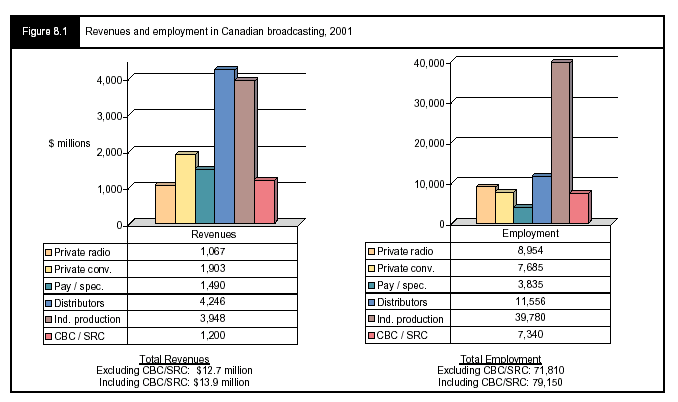 |
|
As for independent production, the Canadian Film and Television Production Association reports that total production activity in Canada in 2001 was about $5 billion, of which about $3.9 billion was on television production. Direct employment in the Canadian production industry was estimated to be about 51,000, which, if pro-rated by the relative contribution of Canadian television to total production, represented employment for about 39,780 Canadians.
Another way to get a sense of the private sector is by looking at its overall profitability since the last revisions to the Broadcasting Act in 1991. Figure 8.2 shows that profits before taxes (PBT) were volatile during this period, ranging from profits of $635 million in 1998 to losses before taxes of $51.9 million in 2001. More details on how these profits/losses vary among key elements of the private sector (i.e., radio, television and distribution) are presented in subsequent sections of this chapter.
|
|
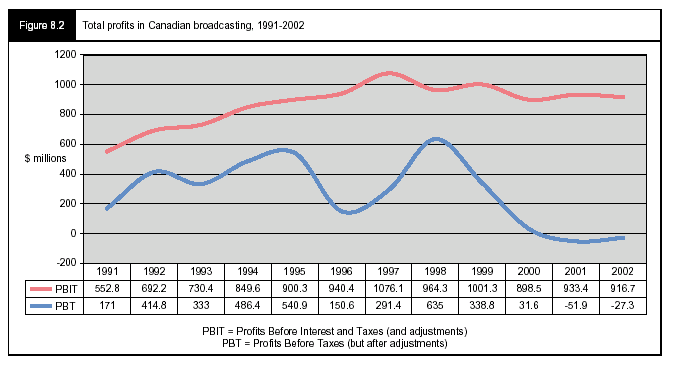 |
|
B. Independent Production
It is important to remember that the main purpose of the Canadian broadcasting system is to support the production and distribution of programs. There are two principal sources of programming content in the Canadian broadcasting system — programs such as news and sports generated by broadcasters, and categories such as drama, documentary and children's shows, some of which are produced by broadcasters, but many of which are developed by independent producers.
People in the industry often make a distinction about whether something was produced in-house or by an independent producer. For example, during 2001-02, the popular French-language téléroman Virginie was produced in-house while the science fiction series Lexx was produced independently.
In the early years of broadcasting most production was carried out in-house and there was very little independent production in Canada. This was especially true between 1952 and 1962 when the CBC and Radio-Canada were the only Canadian networks. There were three main reasons for this. The CBC and Radio-Canada followed the approach used for radio where shows were developed in-house; there was no film production centre (e.g. a Canadian equivalent of Hollywood) from which Canadian programming could be obtained; and, there were no regulations against producing all content in-house.
When CTV began operation in 1961 it quite naturally followed the same pattern, largely because there was no independent production sector from which to obtain material. CTV's production of material, however, was more limited than that of the CBC with a concentration on news and sports. This opened the door for some independent production, particularly game shows and some drama (e.g., It's Your Move, The Littlest Hobo).
On the French-language side it was more difficult to import material, thus forcing the French private broadcaster Télé-Métropole to operate as a producer from its launch in 1960. For this reason, Télé-Métropole (which became part of TVA in 1971) quickly became the leading source of programming for Canada's French-language audiences.1 Examples of programming produced by Télé-Métropole include Quebec's first sitcom, Cré Basile (1965-68) and Lecoq et fils (1967-68). Shows produced under the TVA banner have included: Symphorien (1974-78), Les Brillant (1979-80), and situation comedies Dominique (1977-80) and Peau de banane (1982-87).
A full-fledged independent production sector began to develop with the federal government's creation of Telefilm Canada in 1983 and the CRTC requirement that the CBC, as a condition of licence, purchase at least some of its programming from outside sources.2 To receive funding, projects were expected to meet various Canadian content criteria. Telefilm administered two funds — one for feature films (the Feature Film Fund — FFF) and one for broadcasters (the Canadian Broadcast Program Development Fund — CBPDF).
As explained in Chapter 5, there are now several public and private funding sources for Canada's creators, among these the Canadian Television Fund (CTF), Telefilm Canada, the Department of Canadian Heritage, broadcasting distribution undertakings, provincial or territorial governments and broadcast licence fees. For example, since its creation in 1997, the CTF has supported more than 2,228 projects; that is, about 11,500 new hours of Canadian programming.3
With the creation of Telefilm and the requirement that CBC buy material from outside sources, the independent production sector in Canada began to flourish, producing large numbers of popular programs. Examples include: Anne of Green Gables, Caserne 24, Kids in the Hall, Diva, Babar, KM/H, and The Boys of St. Vincent. Shows such as Trudeau and Le dernier chapitre are more recent examples of successful independent productions. |
|
Two other factors also helped foster the growth of Canada's independent production sector. First, the CRTC has licenced dozens of specialty channels that need special content (e.g., music or science programs). Second, the CRTC has maintained Canadian content requirements for these new services. While these requirements vary by channel, they, by default, create a demand for Canadian programming that can be met realistically only by an independent production sector. Indeed, it would be extremely inefficient to have every specialty channel set up its own production facilities.
At the same time that the Canadian market for independent productions has expanded, specialty services such as The Cartoon Network and Nickelodeon — were also being launched in the United States, each with similar needs for specialized content. During the 1990s, Canadian independent producers met at least some of this demand, thus making it easier to obtain a portion of their funding support from outside Canada.
The ability of independent producers to attract funding from outside Canada has been enhanced by the rise of treaty co-production activity. Canada has signed treaty co-production agreements with many countries and is the world's leading co-producer. In 2001-02, for example, treaty co-productions involving Canadian production houses numbered 107, and were worth $793 million (of which $432 million was spent in Canada).
International Treaty Co-productions
Co-productions are binding international legal agreements between governments designed to assist producers by reducing the risks of production through the pooling of creative, technical and financial resources. Canada has 61 official audiovisual co-production treaties with a variety of countries, most of which are for film and television productions.
Recognition as a treaty co-production grants a production domestic status (i.e., it is a national product) in each jurisdiction. In Canada, this means that a co-production is considered "Canadian Content." Co-production status gives Canadian producers access to federal tax credits and public support (e.g., the Equity Investment Program envelope of the Canadian Television Fund).
The Department of Canadian Heritage is responsible for negotiating co-production agreements, while Telefilm Canada administers these agreements on behalf of the Government of Canada. |
But there are advantages and disadvantages with co-productions. The main advantage is that they can make additional funds available and promote access to foreign markets. On the other hand, they are sometimes very difficult to manage; there are often conflicts over creative control; and, the final product can be culturally non-specific or of little interest to audiences on one side of the partnership. Despite these problems, co-productions have become an important source of additional support to Canadian production companies.
Figure 8.3 gives some sense of the size of Canada's private production sector. As can be seen, Canada's production sector grew notably between 1998 and 2001, from 118 companies to 155. Most of this growth was among smaller companies with revenues of less than $25 million.
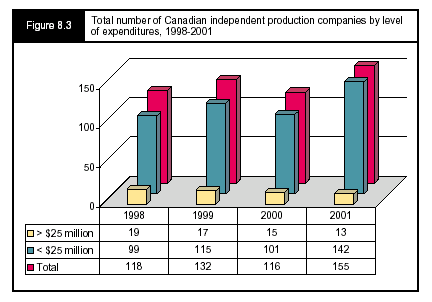
|
|
Canadian Successes in Animation
The Oscar awarded in 2003 to Toronto's Alias| Wavefront for Maya, their 3D animation software, is the most recent of many honours for Canadian animation.
The best known of the early animators are the NFB's Norman McLaren, who first won an Oscar in 1952 for his film Neighbours, and Radio-Canada's Frederic Back, a two time winner for Crac! and The Man Who Planted Trees. Co Hoedeman also won an animation Oscar for his stop-motion Sand Castle. These pioneers have inspired many others through their innovative use of new techniques to support their creative vision.
While most animation is still made with traditional techniques, the digital age brought with it a flood of innovation. Many point to the eight-minute short film, Tony de Peltrie (1985) as a starting point. Tony was the first computer-animated character who could express emotion, and his creators, Philippe Bergeron and Daniel Langlois, went on to develop new software tools used widely throughout the production industry.
Bergeron's Digits 'n Art, for example, created flesh, a 3D paint software application, and LIFEsource, a complete motion capture system. Langlois went on to found SoftImage, which came to world attention through its use in Jurassic Park. Discreet Logic was created by two veterans of SoftImage: their tools, which also won an Oscar, were central to many motion pictures, including Armageddon and Titanic. But these are only three among a host of development companies including Vertigo, Side Effects, and Toon Boom technologies, that are estimated to have produced over half the animation software used in Hollywood.
Canada's educational institutions have also had a role to play in fostering this creativity. Four graduates of the University of Waterloo have received technical Oscars for their part in the creation of three widely used animation packages: Prisms, the Alias PowerAnimator system, and the Marionette 3D system, used in the creation of the first, three-dimensional computer animated feature film, Toy Story.
The year before Toy Story, however, the first computer-generated 3D animated series for television was aired: Reboot, produced by Mainframe Entertainment in Vancouver, used SoftImage and in-house tools. Reboot was not just a technical achievement — it also boasts a clutch of Canadian Geminis and international awards for its creative accomplishments.
Other institutions training animators include the Banff Centre for the Arts, the Emily Carr Institute, the National Animation and Design Centre, Centennial College and Sheridan College. Sheridan alumni include such luminaries as Steve Williams (Jurassic Park, The Mask, and the T1000 cyborg in Terminator), James Strauss (Dragonheart) and John Minnis (Academy Award for Charade).
With this history of creative and technical success, it comes as no surprise that, despite the recent downturn, Canada is the largest exporter of animation in the world. Nelvana's series have been seen in some 160 countries; Cinégroupe's in 125, while Mainframe's output has been seen in 80 countries and in 13 languages. Companies like these and Toronto's Decode, Montreal's Cinar, and Ottawa's Funbag, have, over the years, established a core of expertise and creativity that have given the Canadian animation industry a stunningly successful international profile. |
|
|
|
|
|
Figure 8.4 shows the overall expenditures of Canadian independent production companies for 1998-01. As can be seen, the production sector consistently spent between $1.7 billion and $1.8 billion between 1998 and 2001.
The value of certified film and television production increased by more than 260% between 1993-94 and 2001-02, from $1.9 billion to $5.1 billion. Figure 8.5 shows that in 2001-02, certified Canadian television production was valued at approximately $4 billion, an increase of $1.5 billion from 1996-97. An element of this growth has been the successes of Canadian animation companies. Two vignettes in this chapter highlight the growth of Canada's independent production sector.
| |
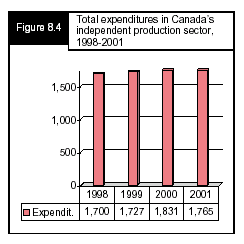 |
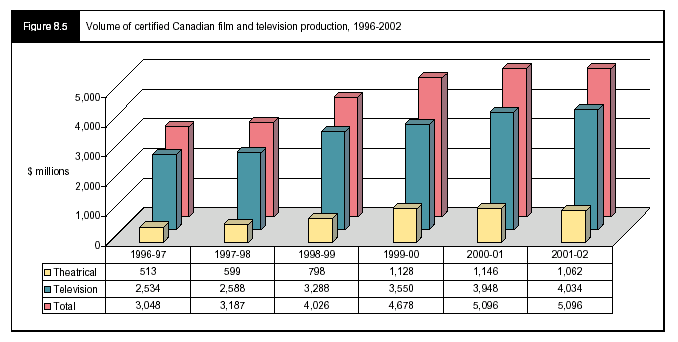 |
|
Figure 8.6 shows the revenues of Canada's top private production companies between 1998 and 2001. It is worth pointing out that the ownership profile of the independent production sector has changed significantly in recent years. Some broadcasters have been purchasing independent production companies (e.g., CanWest Global now owns Fireworks Entertainment and Alliance Atlantis owns Salter Street). Witnesses raised several concerns over this trend. First, when a broadcaster owns a production house, self-dealing may take place. Second, with this type of consolidation, there is the potential for the loss of regional production and the concentration of decision making in larger centres. Chapters 9 and 11 discuss these issues. |
|
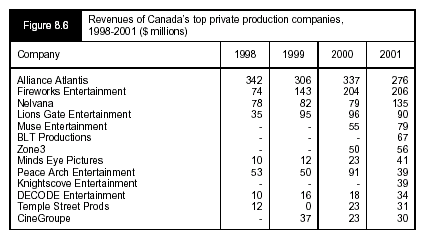
What the Committee Heard
While this section discusses what the Committee heard, it should be pointed out that several other chapters address issues that were raised by Canada's independent producers. For example: Chapter 5 addresses the many specific concerns that were raised by independent producers concerning the funding support system for Canadian television; Chapter 11 discusses the importance of preserving Canadian ownership and control; Chapter 13 talks about the protection of copyright. This section describes some of the general challenges independent producers face when dealing with the existing structure of Canada's broadcasting system.
In her appearance before the Committee, Ms. Annie Piérard, President, Société des auteurs de radio, télévision et cinéma, observed that independent production plays an essential role in the Canadian broadcasting system:
The general principle of diversity underlies the Broadcasting Act and Regulations. ... The legislation also supports the diversity of places where programs are created by fostering a system which calls upon the talents of independent Canadian producers. We can also mention the diversity of access points to the system for artists, creators, producers and distributors, which is supported by the fact that there are many different owners of broadcasting companies. There is diversity in the private and public sectors, which is one of the distinctive characteristics of the Canadian broadcasting system and which must remain so.4
This perspective prompted Ms. Claire Samson, President, Director General, Association des producteurs de films et de télévision du Québec, to make the following comments about the current state of Canada's broadcasting, particularly in the French-language market:
I would like to recall the fact that the Canadian broadcasting system is a unique success; it is the envy of many other countries. If we compare the place held by Canadian programs on radio and on television with that of other Canadian cultural products in unregulated sectors, such as movie theatres, for instance, video clubs or music stores, it is easier to see the positive effects of the regulation which exists in the field of broadcasting.
Of course, regulation isn't everything. We also need creators, talented artists, innovative producers and the financial means to meet the high expectations of the public, but when all these conditions are brought together, success is guaranteed. In a general way, proof of this is that during the regular season, 27 or 29 of 30 most watched French-language programs on television are Canadian programs created and produced at home. We therefore must build on a precious foundation which cannot be lost or compromised.5 |
|
The Power of Knowledge
The new production and communication technologies that are stimulating and advancing multimedia productions, both domestically and abroad, have enabled numerous fledgling companies to carve a place for themselves in the field of television production. These companies, which tend to be small or medium-sized, have been able to put together teams of professionals whose knowledge, allure and ambitions are in perfect harmony with the new multimedia production technologies. A number of Canadian companies are at the top of this category, including the Pixcom Group, a small company that the Committee had the pleasure to visit during its travels across Canada.
The Pixcom Group is a private, Montreal-based communications company established in 1987. It is a young company with a very lofty mission: to become a world-class producer of multimedia content and to further the development of international broadcast technologies. Pixcom wants to be recognized for its excellence, technological expertise, boldness and creativity.
The flexibility and skills of Pixcom's technical and production teams allow the company to meet a wide variety of challenges in the fields of sports, dramatic series, children's programming, variety programs, documentaries and public affairs. Almost every French-language network in Canada, not to mention France 2 and France 3, has aired Pixcom productions, many of which have obtained awards such as the Gémeaux and Gemini. They are proof of the company's world-class work. |
|
|
In her appearance before the Committee, Ms. Julia Keatley, Chair of the Canadian Film and Television Production Association, offered a similarly enthusiastic summary of the contributions that Canada's independent production sector makes to English-Canadian television programming:
Independent producers work in a broad range of formats and genres to give Canadian expression to Canadian stories, interests, and concerns. Primarily we create drama, documentary, and children's programming. When you or your family watch This Hour Has 22 Minutes, The Red Green Show, Degrassi: The Next Generation, Cold Squad, Air Farce, Turning Points in History, Hoze Hounds, Da Vinci's Inquest, The Toy Castle, Blue Murder, Profiles of Nature, or Little Miracles, you might assume you were viewing the creative output of a particular television station or network you are tuned to. In fact, you are watching the work of thousands of talented men and women who make up the Canadian independent production industry.6
Ms. Keatley also pointed out (as discussed in Chapter 5) that independent producers are heavily reliant on taxpayer support and, therefore, strive to be as responsible and as efficient as possible. She explained:
... we're dealing with taxpayers' dollars. One thing that can be said about the independent producers across Canada, whether they're making documentaries, children's programs, or dramas, is they're fairly lean and mean. We're out there to produce artistry, to be creative, to make a living.7
But maintaining a balance between creativity and efficiency is not without its pressures. As Mr. Ira Levy, a Board Member with the Canadian Film and Television Production Association told the Committee:
It's important to realize that when you actually look at how programs are funded, you'll see that it's the producer that takes the biggest risk. Not only do we take artistic risks ... but we take creative risks and financial risks.8
For this reason, Canada's creators have become — by necessity — highly skilled business people. As Ms. Barri Cohen, National Chair of the Canadian Independent Film Caucus, told the Committee:
As filmmakers, we combine the specialized skills of making programs for television with the business acumen to run our companies and raise the funds to make our work. Documentary makers have become a vital component of the independent production sector, contributing over $200 million worth of production per year.9
But this need for sound business skills has not been detrimental to the growth and success of the industry. On the contrary, Mr. Stephen Ellis, Past Chair, Canadian Film and Television Production Association, told the Committee that:
... it's ... a very cost-effective situation, because as we mentioned in our opening remarks, the broadcasters — and this includes the CBC typically only invest about a quarter of what it costs to produce.10
Furthermore, this situation has so enhanced the important role of the independent sector that it has:
...grown to a point where somewhere in the order of 80% to 90% of the entertainment programming in prime time on the CBC is actually provided by the independent sector, which has the advantage of providing more diverse voices.11
All this being said, witnesses did point to several challenges independent producers face in today's broadcasting environment. These include: the abuse of market advantage, self-dealing, gatekeeping, competition for available funds, and the need for a coherent regulatory framework. With regard to the first two of these issues (market advantage and self-dealing12), a witness told the Committee that:
... in an environment with fewer players [i.e., broadcasters], there is real potential for the abuse of market advantage. In the past, a broadcaster would typically obtain rights to show a film or series, for instance, over several years for a certain number of plays with some guarantees of promotion. Now they may want to pay the same fees but ask or demand that their sister channels share the right to broadcast such programs as well for an unlimited number of plays without offering any additional moneys and with limited publicity guarantees.13
Moreover:
We have heard from senior filmmakers and producers that this environment of what we call "forced tied sales" is going on unabated. Market advantage also means broadcasters can set up their own in-house documentary companies, as Alliance Atlantis and Discovery have done, and that these companies feed the constant demand for low-end, low-cost documentary programming for themselves while accessing public funds and tax credits to do so.14
For this reason, Mr. Alexander Crawley called on the Committee to ensure that the CRTC enforce more stringently existing self-dealing regulations.15 It is his organization's view that:
The self-dealing regulations that the CRTC has put in place to guard against such practices are not being enforced with sufficient rigour, in our opinion, and this needs to be urgently addressed.16
Another challenge facing independent producers, raised by Mr. Stephen Ellis, is the extent to which broadcasters can act as the system's gatekeepers. He explained that:
... in our negotiations with broadcasters, ... they are now such powerful gatekeepers, ... because it is through them that a producer gets to apply for the CTF and for funding from Telefilm and various other sources.17
This reality, he added:
... gives them the power to acquire a disproportionate share of or interest in the programming that producers would like to produce and retain and ultimately generate some profit from.18
Another challenge mentioned by several witnesses was how fragmentation has led to more intense competition to obtain funding from the CTF, Telefilm and the various private funds. As Ms. Barri Cohen explained:
The available pie of funds for all just got more fragmented, with less to go around for everyone. I think that's why a lot of folks struggle with the contradiction between more money seemingly into the system — which has been referred to before, and that's true — but it has been outpaced by licensing [of more broadcasters]. So the pie may have gotten somewhat larger, but it's essentially more fragmented.19
Taken as a whole, the above concerns help explain why independent producers cautioned the Committee to be wary of the recommendation made by the Canadian Association of Broadcasters that private broadcasters be granted direct access to the Canadian Television Fund. As Mr. Mark Laing, Chairperson, Directors Guild of Canada, told the Committee:
The Canadian Association of Broadcasters is lobbying very heavily for broadcaster access to the Canadian Television Fund. If they are allowed to access those finances directly, it makes a lot of independent producers redundant in the grand scheme of things. It's very threatening to us, as a community, in our ability to bring innovative, interesting, and relevant content to an audience.20
Ms. Elizabeth McDonald, President and Chief Executive Officer, Canadian Film and Television Production Association (CFTPA), also stressed this point and added that the time has come for a new, coherent framework to govern the working relationship between Canada's independent producers and the broadcasters. As she noted:
... let me be clear about one thing about Canadian television and where it's bought — from what producers. It is up to broadcasters, first of all, to license that programming. No project will go forward to any fund unless it's been licensed. And certainly with consolidation, where the licensing is done is becoming an issue. That's one of the reasons we're talking about a coherent framework, where the CRTC licenses. In some cases there are some regional conditions of license; in other cases there are not. How we ensure that there's an opportunity for all of those stories, in English and French, to be seen across this country is going to be a challenge when most of the broadcasters are located centrally.21
With this in mind, Ms. McDonald's association made the following policy proposals:
... it is absolutely vital that the Canadian Television Fund be recognized as an essential component to the funding structure for distinctly Canadian programming and that it receive stable, long-term funding support from the government.
... it is essential that broadcasters continue to provide access on their channels for the programs we create.
... public agencies should streamline their administrative procedures so producers are not penalized with additional financing costs.22
Similarly, Mr. Jacques Primeau, President of the Association québécoise de l'industrie du disque, du spectacle et de la video, told the Committee that:
... regulations could be both streamlined and rendered more efficient ... by strengthening and adapting to the emerging technological and competitive environment those aspects of the regulations which help meet the essential objectives of the act, by ... more systematically turning to self- and co-regulation, and by regulating the contractual relationships with respect to the administrative, commercial, technical and social provisions contained in the current body of regulations.23
Proposed Solutions
The Committee regards the growth and achievements of independent television production in Canada as strong evidence that the principles of Canada's broadcasting policy for this sector, as articulated in the Broadcasting Act, are being realized. At the same time, it notes that there are valid reasons for serious concern and agrees that measures must be taken to ensure the future health of this sector. In particular, it agrees with witnesses that changes in ownership make it essential that the CRTC enforce its existing regulations on self-dealing.
It is important to point out that other chapters in this report also deal with many of the issues raised by witnesses concerning the independent production sector. For example:
| • | Chapter 5 recommends that the Canadian Television Fund be recognized as an essential component of the Canadian broadcasting system. |
| • | Chapter 5 makes several recommendations designed to remedy many of the problems witnesses raised concerning the structure of the Canadian content point system and the administration of the production funds. |
| • | Chapter 11 calls for a moratorium on the CRTC approval of any further cross-media ownership changes until government issues a coherent policy on this issue. |
The Committee also recognizes that steps may be required to ensure the widest possible distribution of Canadian programming. It notes that a consistent theme of this report is the conviction that the Canadian broadcasting system should be maintained as a single system. As pointed out in Chapter 4, however, complete and coherent information on the distribution and exhibition of Canadian programming is sorely lacking. This has made it very difficult for the Committee to determine the extent to which certain issues required further consideration.
A case in point is the CFTPA's concern that regional variations in conditions of licence lessen the exhibition of Canadian programming. The Committee agrees that this is a troublesome issue. This is why Chapter 5 recommends ongoing research on the distribution and exhibition of Canadian programming across Canada. Indeed, once such research is undertaken, relevant stakeholders would be far better positioned to make informed decisions concerning the need for any eventual changes in broadcasters' conditions of licence for the exhibition of Canadian programming.
C. Radio Broadcasters
As explained in Chapter 2, broadcasting in Canada can trace its origins to the private sector. Between 1919, the year the first radio broadcasting licence was granted to Marconi Wireless Telegraph Company of Canada, and 1932, the year when the recommendations of the Aird Commission were put into effect, private enterprises provided almost all radio broadcasting services. In 1928, there were 68 private radio broadcasters in Canada.24 These radio broadcasters were mainly amateurs, families and non-profit groups. It is interesting to note that during the period from 1919 to 1940, just three radio groups developed: Taylor Pearson and Carson, the Roy Thompson Group, and the Siftons.25
In 1932, following a recommendation by the Aird Commission, the Canadian Radio Broadcasting Commission (CRBC) was created. The CRBC was entrusted with developing public broadcasting and regulating all broadcasting. The economic situation of the 1930s, however, did not allow the government of the day to provide adequate funding to the CRBC. For this reason, it was able to establish just five radio stations.
Since public radio stations could not meet public demand, private radio broadcasters were called upon to broadcast the programming of the CRBC. The advent of the CBC, which replaced the CRBC, maintained this model. Thus, in 1943, the three CBC networks (two English-language and one French-language) had at their disposal 10 public and 72 private stations.26 At that time, private stations were forbidden from creating networks; this restriction, however, did not prevent the proliferation of private stations in large numbers.
Services
Figure 8.7 shows the total number of English- and French-language radio services in Canada today. There are about 600 radio stations that serve Canada's English-speaking communities and nearly 200 serving Canada's French-speaking communities. This figure also shows the level of service for Canada's third-language (18), native (37), religious (24) and local communities (68).
|
|
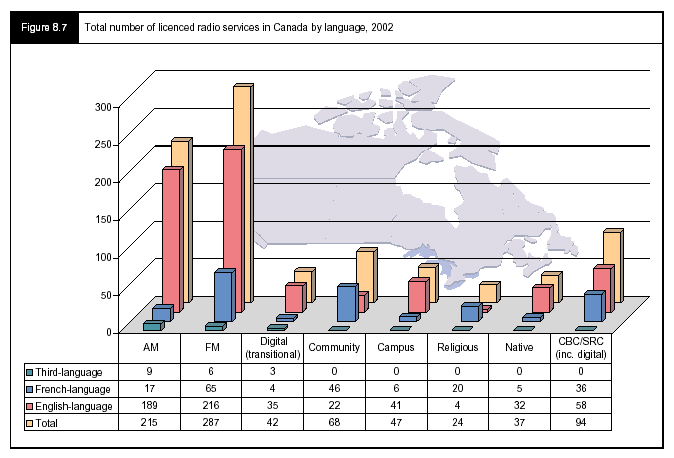 |
|
Ownership
In 1998 the CRTC revised its policy for the ownership of commercial radio stations as follows:
In the Commission's view, increased consolidation of ownership will enable the radio industry to strengthen its overall performance, attract new investment, and compete more effectively with other forms of media. Accordingly, the Commission has revised its policy on common ownership. The Commission is satisfied that the revised policy will provide for a strengthened radio industry, while responding to longstanding concerns regarding diversity of news voices, media cross-ownership and fair competition.
Accordingly, in markets with less than eight commercial stations operating in a given language, a person may be permitted to own or control as many as three stations operating in that language, with a maximum of two stations in any one frequency band. In markets with eight commercial stations or more operating in a given language, a person may be permitted to own or control as many as 2 AM and 2 FM stations in that language.27
Figure 8.8 shows the top 10 radio ownership groups in Canada. As can be seen, the top four groups owned 188 radio stations, that is, 38% of all private radio stations in Canada. Furthermore, the top 10 groups accounted for 77% of all radio revenues in 2001.
|
|
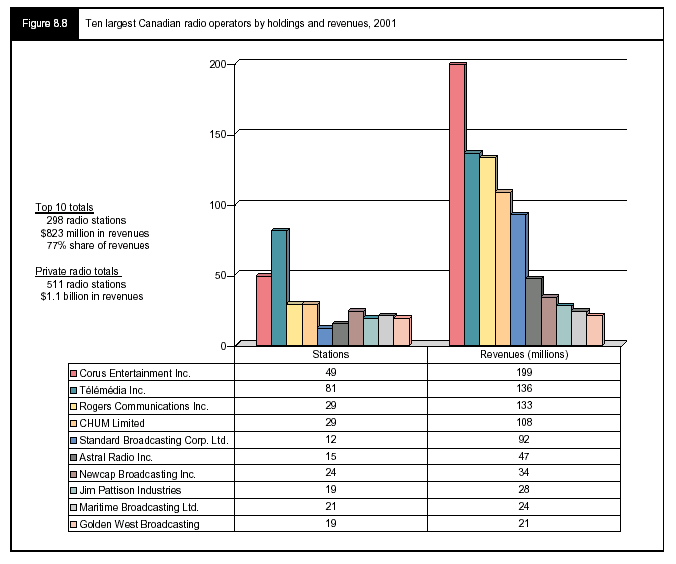 |
|
Revenues and Profits
The 1986 Report of the Task Force on Broadcasting Policy wrote of a balance being struck between commercial interests and public policy goals. One indication of where the balance has been struck is by looking at the profitability of the private broadcasters.
Figure 8.9 shows that total revenues for Canada's private radio stations have grown over the past four fiscal years. It reveals that private radio in Canada generated about $900 million in revenues in 2001. It also shows that AM revenues remained relatively flat during this period, whereas FM revenues, due to the transition of many stations from AM to FM frequencies, were on the rise.
|
|
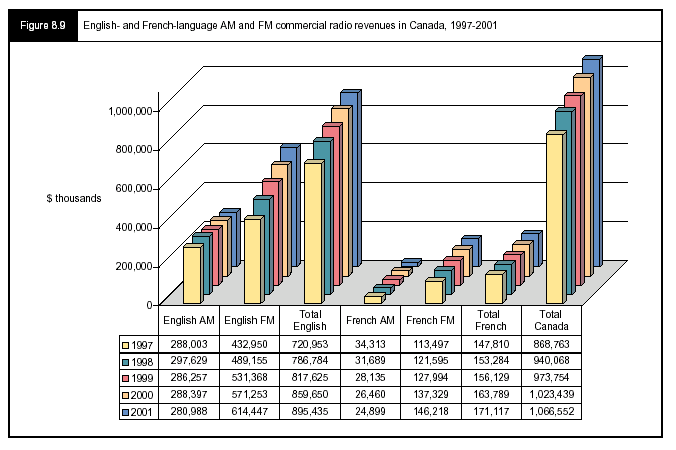 |
|
Finally, figure 8.10 shows the overall profits of private radio in Canada for the period 1991-2002. These data reveal that the sector was unprofitable between 1991 and 1994. Since that time, however, profits have increased substantially.
|
|
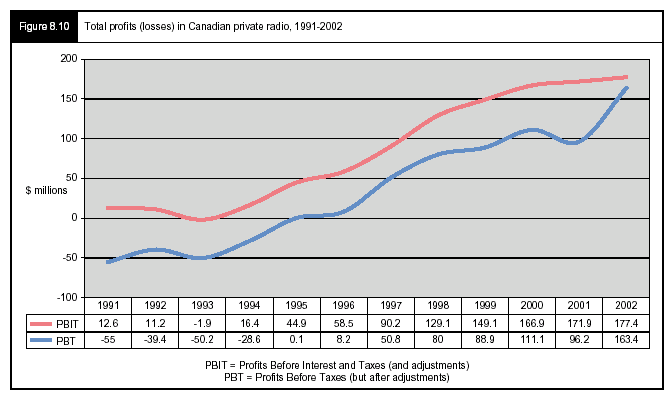 |
|
Radio Formats
As noted in Chapter 4, measuring audiences to radio is a difficult undertaking. Part of the problem is the lack of any consistent or agreed-upon categories to describe radio stations. A second problem is that programming broadcast on radio is not classified into separate genres the way it is for television. This means that when we talk about radio, we can only talk about the format of a station as a whole. Figure 8.11 shows the most popular radio formats in fall 2000 and fall 2001. Overall, the adult contemporary format was favoured by nearly one-quarter of all listeners, while the "gold/oldies/rock" format was the format of choice for 18% of Canadian radio listeners.
|
|
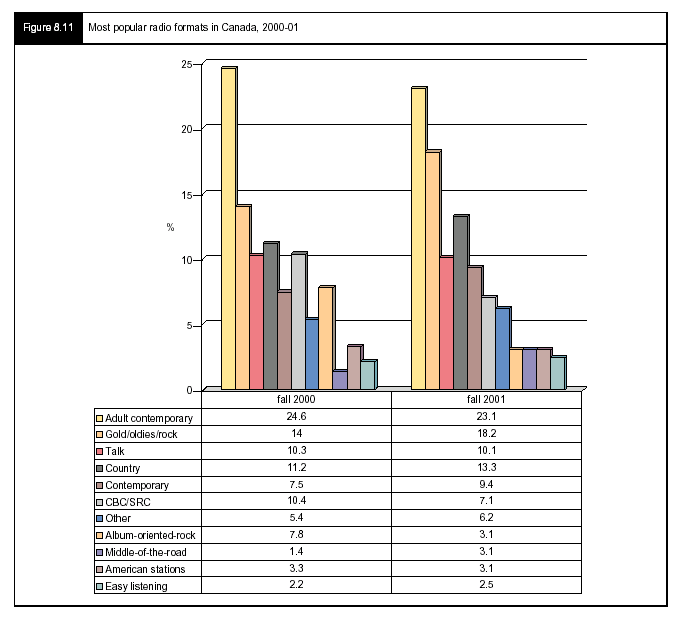 |
|
Canadian Content Policies and Regulations for Commercial Radio
The CRTC's Commercial Radio Policy has three main objectives:
... to ensure a strong, well-financed radio industry that is better poised to achieve its obligations under the Act and to meet the challenges of the 21st century. ... to ensure pride of place for Canadian artists. ... to ensure that a French-language presence in radio broadcasting is maintained.28
|
|
To meet these objectives, the Commission imposes the following Canadian content requirements on commercial radio broadcasters:
All radio stations [English and French] must ensure that 35% of their popular musical selections are Canadian each week. In addition: Commercial radio stations must ensure that 35% of the musical selections they air between 6 a.m. and 6 p.m., Monday through Friday, are Canadian. ...
French-language radio stations must ensure that at least 65% of the popular vocal music selections they broadcast each week are in the French language. As well, at least 55% of the popular vocal music selections broadcast between 6 a.m. and 6 p.m., Monday through Friday, must be in the French language.29
A system known as MAPL is used to identify Canadian music. To qualify as Canadian a musical selection must generally meet at least two of the following four criteria:
M (music) — the music is composed entirely by a Canadian.
A (artist) — the music is, or the lyrics are, performed principally by a Canadian.
P (production) — the musical selection consists of a live performance that is recorded wholly in Canada, or performed wholly in Canada and broadcast live in Canada.
L (lyrics) — the lyrics are written entirely by a Canadian.30
Unfortunately, very little can be said about the overall delivery of Canadian content programming on commercial radio in Canada. This is because the CRTC does not track compliance until a radio station's licence is up for renewal. Based on these limited data, the CRTC reported in November 2002 that 95% of 37 radio stations were in compliance with the all day requirement and 92% were in compliance between 6 a.m. and 6 p.m. As for French vocal music, 67% of six radio stations were in compliance with the all day requirement, while 67% met the requirement between 6 a.m. and 6 p.m.31
Canadian Talent Development
To foster Canadian musical talent, the CRTC issued a Canadian Talent Development policy (CTD) in 1995.32 This policy requires AM and FM radio stations as a condition of licence to contribute to Canadian talent development by making annual payments to eligible third parties as defined by the Canadian Association of Broadcasters (CAB). In 2001, there were more than 350 eligible third party CTD organizations. Eligible organizations include two music funds, Factor and MusicAction, as well as national and provincial music organizations, performing arts groups, schools and scholarship recipients.33
Regrettably, the CRTC does not collect annual data on the impact of its Canadian talent development policy. In 2000, however, the Canadian Association of Broadcasters conducted a survey of its members to assess the value of CTD contributions. Figure 8.12 shows the CAB's findings. As can be seen, 267 private radio stations contributed more than $16 million to Canadian talent development in 1998-99. According to the CAB, this total increases to $20 million if adjusted to take into consideration the Association's entire radio membership.
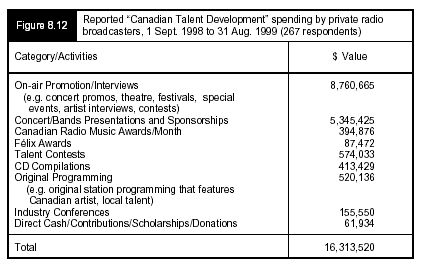
|
|
The Canadian Music Industry – A Success That Deserves Celebration
In the year 2002, 113 Canadian musicians had records certified as gold, platinum, or diamond. This was an increase of 86% on the previous year, a remarkable success at a time when CD sales have declined and Internet file sharing endangers the economic base for music.
One should not downplay the threat to the industry. But it is important nonetheless to pause and reflect on the huge successes of Canadian music in the years since 1971.
It is in 1971 that the CRTC first required radio stations to dedicate 30% of their music playlists to Canadian music — that is, cuts that met two out of the four possible criteria (Canadian Music, Artist, Production or Lyrics). At the time, the move was very controversial. Was there enough good Canadian music to fill the airwaves? The answer was probably not. In those days, there were few Canadian records, and those musicians who became stars — like Joni Mitchell, Leonard Cohen, Ian and Sylvia, and Gordon Lightfoot — had little chance to record in Canada. To make it in Canada, you first had to make it in New York or Los Angeles.
What the MAPL rules did was create a demand for Canadian records, and that, in turn, called a Canadian record industry into being. Thirty years later Canada has an abundance of top stars in music who are recognized worldwide. Artists like Céline Dion, Shania Twain, Diana Krall, Nickleback, Avril Lavigne, and 108 others made the gold, platinum, and diamond-selling records of 2002 — and next year there will be new names to add to the list.
To be sure, the domestic industry has its problems. With better access to global backing, our best artists may bypass our domestic industry on their way to international success. And unless the Internet puzzle is solved, the whole industry is in trouble everywhere.
But the measure of success for the MAPL program is that it continues, year after year, in all styles, to foster the development of great musicians and great Canadian music. It is, arguably, the single most successful policy measure in the history of Canadian broadcasting. |
|
|
It is worth noting that the CAB is of the view that these expenditures are largely voluntary contributions since: "... these are voluntary commitments undertaken by stations that go above and beyond those required by the Commission as part of radio broadcasters CTD condition of licence (COL) requirements."34 Indeed, according to the guidelines agreed upon by the CRTC and the CAB in 1996:
The purpose of the CAB Distribution Guidelines is to ensure that Canadian radio stations, considered together, allocate a minimum of $1.8 million each year to eligible third parties associated with Canadian talent development.35
The Radio Starmaker Fund / Fonds RadioStar
It is important to remember that Canada's private radio broadcasters are dependent on the music industry for their supply of Canadian recordings. For this reason, the Radio Starmaker Fund and Fonds RadioStar were created in the fall of 2000. The initial idea for these Funds flowed from suggestions made by the Canadian Association of Broadcasters during the 1997 commercial radio policy hearing, that the existing benefits test be replaced with a minimum contribution to FACTOR/MusicAction, and a new Canadian music marketing and promotion fund.
The Foundation to Assist Canadian Talent On Record (FACTOR)
As a private non-profit organization and an industrial strategy, FACTOR is dedicated to providing assistance toward the growth and development of the Canadian independent recording industry. The funds not only assist Canadian recording artists and songwriters in having material produced, videos created or to tour internationally, but they also provide support for Canadian record labels, distributors, producers, engineers, directors — all those facets of the infrastructure which must be in place in order for artists and the Canadian independent recording industry to progress in the international marketplace.
MusicAction
MusicAction, a non-profit organization, was created in August 1985 on the initiative of professionals of the Quebec radio, record and entertainment industries. The foundation's chief objective is to foster the development of Francophone vocal music by supporting the production, marketing and promotion of sound recordings. World music, classical music and instrumental music projects are also eligible for support. MusicAction is also mandated to provide an umbrella organization for the Canadian independent recording industry. |
The CRTC endorsed the CAB's initiative and asked that it develop a proposal in coordination with the Canadian Independent Record Production Association, the Canadian Recording Industry Association and the Association québécoise de l'industrie du disque, du spectacle et de la vidéo. The Radio Starmaker Fund is for the English-language music industry and the Fonds RadioStar is for French-language Canadian artists. The Fund is supported by a 3% charge on the value of all ownership transactions involving profitable radio stations. The funds have been fully operational since fall 2001 and have, to date, committed over $4.2 million to Canadian artists. It is expected that the funds will continue to support Canadian artists at this level for the next 8-10 years.
The stated purpose of the funds is to "make a substantial and discernable difference to the careers of Canadian artists" by providing a substantial incremental investment where the artist has established a proven track record and his or her label is making a significant investment in his or her career.36 Monies provided must be incremental to existing investments being made for promotion and marketing of Canadian artists.
The funds support emerging artists with star potential from every region of Canada. The aim is to spend the money in a way that will make a difference. For this reason, monies are not spread thinly, but are spent on a small number of ventures to help artists achieve the breakthroughs needed to become stars. The ultimate objective is to be involved in the business of increasing the supply of good, playable Canadian music.
The application process anticipates and requires that both the artist and the record label will submit one application per project with both parties signing and submitting the application. A manager or publisher may also apply in conjunction with an artist provided that it can be established that a significant non-recoupable investment is being made in an artist.
What the Committee Heard
Very few witnesses talked about private radio; when they did talk about radio, it was typically within the context of discussions about the state of the CBC/SRC, community radio and copyright. These issues are dealt with in chapters 6, 9 and 13, respectively.
When the Minister of Canadian Heritage appeared before the Committee, she observed that Canadian content rules for radio: "have helped to create an extraordinary domestic and international success for Canada's music industry."37 Many witnesses agreed with this perspective. Mr. Glenn O'Farrell, President and Chief Executive Officer, Canadian Association of Broadcasters, told the Committee:
The Minister of Canadian Heritage and her officials have demonstrated their commitment to the continued development of popular Canadian music through the Canada Music Fund but also, interestingly, through the Investment Canada Act. ... We applaud that. These are significant benefits, which strategically bundled with public and private money make a considerable difference in the cultural products we produce. ... As a result, we have some tremendous English and French music stars in this country, and for many music formats on radio there is an excellent supply of Canadian music selections.38
Similarly, Mr. Mark Maheu, Vice-President and General Manager with CFRA/KOOL-FM observed that Canada's approach to regulation, marketing and promotion has led to "some very major successes like Céline Dion, Éric Lapointe, the Barenaked Ladies, and Shania Twain, and rising stars like Nellie Furtado, Kevin Parent, and Sum 41."39
But it is not just regulation that has enabled many Canadian artists to reach the levels of national and international popularity that they enjoy today. As Mr. Claude Gagné, a representative from the Télémedia radio group, told the Committee, specific challenges have also necessitated that private broadcasters develop new strategies to nurture talent. He explained:
Almost 30 years ago, FM radio regulations came into force to provide a regulatory framework for emerging FM radio. ... At the time ... a radio broadcaster could fill half of his French-language programming requirement with music from Europe and elsewhere. ... At the same time, Quebec music was booming, with groups and music emerging like Beau Dommage, Harmonium, Charlebois, and many others, which gave Quebec a flourishing and dynamic music industry in the unique North American environment.
Over ... the past ten years, this has changed. France produces ... much less music than it did before ... In order to counter the drop in high-quality musical sources, radio broadcasters had to find solutions themselves. The result was a Quebec star system that has its own stars, honours and institutions. Canadians and Quebeckers, to whom local stars are very important, were instrumental in helping the system take hold. Many research tools used by broadcasters confirm this view: Canadians like Canadian artists. That is where the strength of the Canadian broadcasting system lies. Broadcasters were the first to understand the need to give emerging artists an opportunity to ensure the industry's succession by promoting shows, festivals and CDs, giving away tickets on the airwaves, establishing intimate, exclusive-unplugged concerts, and implementing a vast range of other initiatives to give emerging artists the tools they needed to expand, produce, sell and innovate.40
These successes, however, should not be seen as a sign that all is well in Canadian radio. On the contrary, as Mr. Mark Maheu observed:
... in key music formats such as adult contemporary and classic rock, there is still too little music to choose from, and there are too few major stars to maintain a steady and fresh flow of Canadian content for radio, where 35% is the Canadian content threshold for most popular music formats.
Some radio formats face content problems when major recording stars take a break from producing music. In addition, these artists can burn out too quickly when back in rotation. Some recent examples of that would include artists like Amanda Marshall and the Tragically Hip.41
Echoing a similar perspective, Mr. Claude Gagné noted that:
We are extremely proud to see our panoply of stars garnering success in France. They include Garou, Lynda Lemay, Isabelle Boulay, Natasha St-Pier and, before them, Céline Dion and Roch Voisine. It is the Quebec star system and private broadcasters that have made it possible for these artists to go from being unknowns to superstars in such a short time.
But the system is fragile. It is dynamic but also risky, with hazards of over-exposure and over-dependence. ... [U]nfortunately, French-language and Canadian content requirements do not take into account drops in production, or less generalist waves of musical creativity. When a station fills its 65% French-language requirement with primarily Quebec material, Canadian content can reach 50%, exacerbating the over-exposure problem. Although adult audiences may like familiar, well-known tunes, younger audiences want new music. When listeners hear the same tunes over and over again and get nothing new, they may tune in less or drop the station all together. That is not in anyone's best interest.42
With these concerns in mind, it was argued by some that the time has come to rethink the existing regulatory approach used for Canadian radio. For example, Mr. Mark Maheu stated:
The point is that we need some fresh approaches in order to continue building a robust Canadian music industry that will be able to attract Canadian listeners and consumers. Much of what we have done in regulation, marketing, and promotion has given rise to success, but we can do more to bring even greater success to both Canadian radio and Canadian music.43
And, Mr. Claude Gagné observed:
That it is ... a good time to review what has worked in the past for Canadian artists and what could work better. It is also an excellent time to examine initiatives that could inspire and encourage broadcasters to do more, or to do things differently. In addition, if we want broadcasters and artists to prosper and evolve together, then the success of one group cannot be at the expense of the other.44
For his part, Mr. J.J. Johnston, General Manager and Vice-President, Programming, Corus Entertainment Inc., suggested two solutions: "Let's start giving more airplay to new artists, and let's start counting music performed by Canadians as Canadian content."45 To this end, he proposed that the MAPL system be redeveloped to encourage radio stations to devote more airtime to new Canadian artists. He explained:
... as it stands you need to have two points to qualify as a Canadian selection. This has resulted in numerous cases where content performed by Canadians is not counted among Canadian selections. For instance, recordings performed by Canadians such as Céline Dion, Neil Young, and Ronnie Hawkins have not counted as Canadian content in the past.
Alternately, recordings performed by non-Canadians such as Rod Stewart and Aerosmith have been counted as CanCon. To broaden available Canadian recordings in a number of radio music formats, we need to increase the point allocation for artists from one to two points, thereby allowing recordings performed by Canadian artists to count as Canadian content, which is a proven method in the feature film sector and which is also currently used by CAVCO.46
With the above points in mind, Mr. Glenn O'Farrell, speaking on behalf of the Canadian Association of Broadcasters, made the following recommendations:
... we call on the Minister of Canadian Heritage to direct the CRTC to examine regulatory incentives to stimulate the supply of music and the development of stars in two ways. The first ... is by crediting the airplay of new Canadian artists, for both English language and French vocal music, at 1.5 selections toward the 35% CanCon requirement, when radio plays the new selection within 12 months of its release. Second is modernizing the rules for what counts as Canadian by allowing a two-point credit when a song's performer is Canadian.47
Proposed Solutions
Overall, the Committee recognizes the achievements of the Canadian radio industry but is very concerned about its long-term health. With this in mind:
RECOMMENDATION 8.1:
The Committee recommends that the Department of Canadian Heritage create a committee composed of radio industry stakeholders to review and determine the level of success of the MAPL system. This study should include a review of definitions of Canadian content and the ways in which the system can foster the development of new artists. |
The Committee is also troubled by the absence of useful data on radio in Canada. In particular, it finds it unacceptable that the CRTC does not collect more comprehensive data on the radio industry and that it has permitted the Canadian talent development initiative to operate without any formal reporting mechanisms since 1996. With this in mind:
RECOMMENDATION 8.2:
The Committee recommends that the Department of Canadian Heritage, in collaboration with the CRTC and radio industry stakeholders, develop a strategy to monitor and report annually on the extent to which the public policy goals for Canadian radio are being achieved. |
The Committee is of the view that such a report should include data on the overall airplay and types of Canadian music and radio programming (e.g., local news, non-news, public affairs, community), as well as more complete information on the ways in which money is invested into Canadian talent development. Such a review should also include an annual report on MAPL or its successor.
|
|
|
|
D. Television
As noted in Chapter 2, television broadcasting made its official debut in Canada with the launch of CBC stations in Montréal and Toronto in 1952. At first, each Canadian market was limited to one station, public or private, which was expected to broadcast the national programming provided by the CBC. It quickly became apparent, however, that Canadians wanted more stations and programs.
During the 10 years following its inception, television grew at a spectacular rate in Canada. By 1961, there were 68 television stations, of which 9 belonged to the CBC and 59 to private companies. As for rebroadcasters, there were 55, of which 8 belonged to the CBC and 47 to private interests.
Beginning in the 1960s, private networks were licenced across Canada: the English-language Canadian Television Network (CTV) in 1961, Télé-Diffuseurs Associés (TVA) Quebec in 1971 and Global in Ontario in 1974. Today, there are five national networks, three English-language (CBC, CTV and CanWest Global Communications) and two French-language (SRC and TVA). There are also several regional networks, operated by CHUM, TQS and the Craig Broadcasting Group.
Services
Figure 8.13 shows the scope of Canadian television services in 2002.48 According to these data, there are nearly 500 television services available to English-speaking Canadians, more than 100 French-language services, 27 third-language services and almost 250 community cable service providers. This figure also shows that Canadians enjoy access to more than 90 foreign television services.
|
|
The CHUM Story
Even when Citytv first went on the air in 1972, it was unlike other television stations. Using a low-powered UHF transmitter and lightweight equipment, it was the first to recognize the realities of the cable television age, and the first to embrace urban culture as its distinguishing style.
But in 1987, the new CHUM building opened in Toronto, and with it came a whole new model for creating television. While it is the home to Citytv and CHUM's family of specialty channels, this building contains no traditional studios. Instead, every space in the building is a potential set for television. Cameras and mikes are portable, and use a network of 35 "hydrants" to send their signals to the control rooms that assemble City, MuchMusic, MuchMoreMusic, Space and the many other channels which originate in the building.
Hosts work without scripts, moving freely from area to area; camera operators follow them, maintaining a seamless "uncut" video flow. Famous musicians perform live in the streetfront/storefront space with fans only steps away, and others watching through the building's huge street level picture windows. Outside the building, "videographers" interview their guests with a camera perched on one shoulder, watching the guest through the lens. In co-founder Moses Znaimer's words, the building "shoots itself".
|
|
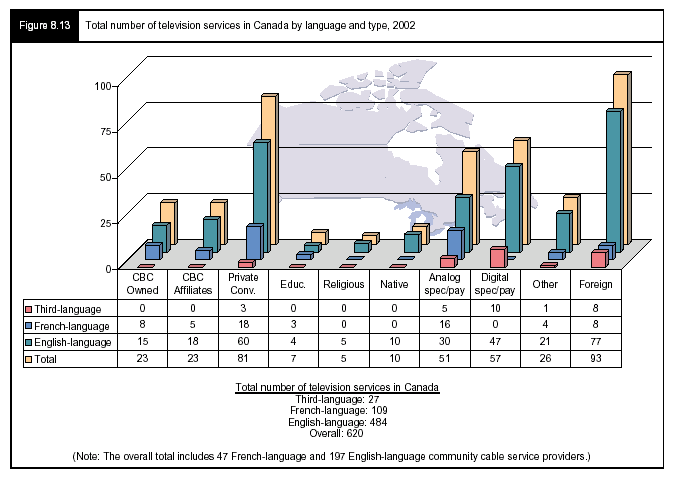 |
|
Revenues and Profits
Private broadcasters derive most of their revenues from advertising and subscriptions. Figure 8.14 shows advertising and subscription revenues in the Canadian television system (including conventional television, specialty services, pay television and BDUs) for the period 1990-2002.49 This figure highlights the increasing importance of subscription revenues for Canada's broadcasting system in today's marketplace. It shows that subscription revenues surpassed advertising revenues in 1990 and that this gap has only widened since that time.
| |
|
The success of the spontaneous "live, local, and interactive" format created by City is emphasized by its adoption around the world. Not only is it the chosen style of eight CHUM stations in Canada, but it has also been exported to Citytv Bogota, Citytv Barcelona, MuchMusic Argentina, MuchUSA, and the "Station within a station", Jyrki, part of Finland's MTV3.
|
|
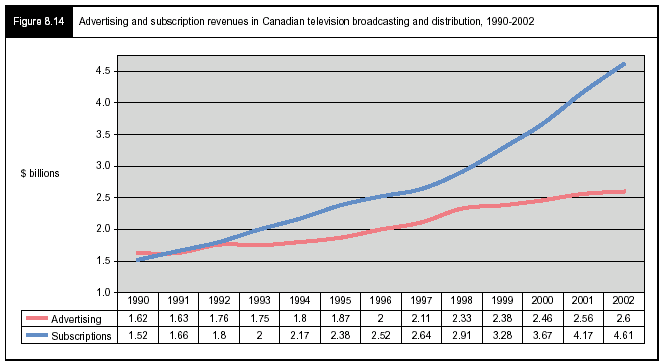 |
|
It is worth pointing out that a certain portion of advertising revenue comes from simultaneous substitution (see inset and figure 8.15), a practice whereby American commercials are replaced with Canadian commercials during the simultaneous broadcast of programming on an American network for which a Canadian broadcaster has purchased the rights. While there is some disagreement as to the exact value of simultaneous substitution, the Canadian Association of Broadcasters in a brief submitted to the CRTC in 1998 suggested that this policy represents "some $150 million annually in advertising revenue."50
Simultaneous Substitution
Simultaneous substitution, which has been in place in Canada since 1976, is an example of how technology can be used to protect the financial stability of Canadian broadcasting. Canadian broadcasters often buy the Canadian rights for U.S. television programs and show these programs at the same time they are shown by the U.S. networks. Under simultaneous substitution regulations, a network may request that broadcasting distribution undertakings (BDUs) replace the advertising on an American network with the Canadian network's advertising for that program. The program Law & Order, for example, may be shown on Tuesday at 9:00 p.m. by both CTV and NBC, with Canadian viewers seeing CTV's advertisement on both channels.
Not all U.S. programs are subject to simultaneous substitution. Only if a Canadian broadcaster is showing the same show at the same time may the substitution be requested. The regulations, moreover, do not apply to the smallest BDU systems. Still, simultaneous substitution covers the most popular U.S. programs shown in all major market English-language markets in Canada.
|
| |
|
Not resting on its laurels, CHUM recently became the first television group in Canada to regularly offer interactive television in its signals, and Citytv was licenced as the first high-definition digital television station in the country. CHUM's dedication to the leading edge continues. |
|
 |
|
Figure 8.16 shows revenues for private conventional television, pay-per-view and specialty services for the period 1996-2001. Overall, revenues in Canadian television broadcasting increased by more than $1 billion — from $2.3 billion to $3.4 billion — between 1996 and 2001.
|
|
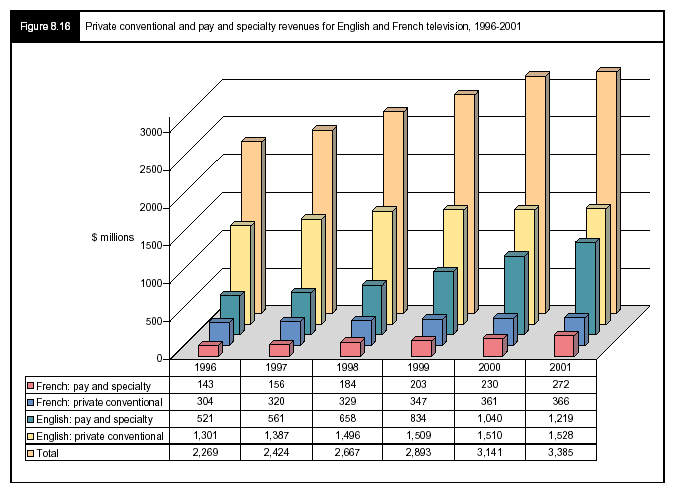 |
|
Figures 8.17 and 8.18 show television PBIT and PBT for commercial and pay and specialty television services for the period 1991-2002. In general, the profitability of pay and specialty services increased during this period. Overall, however, these figures show that profits before taxes for television were volatile during this period. For example, conventional television services experienced losses of almost $70 million in 1991 and profits of $182.7 million in 1999. Similarly, profits for pay and specialty services ranged from a low of $37.3 million in 1996, to a high of $194.9 million in 2001.
|
|
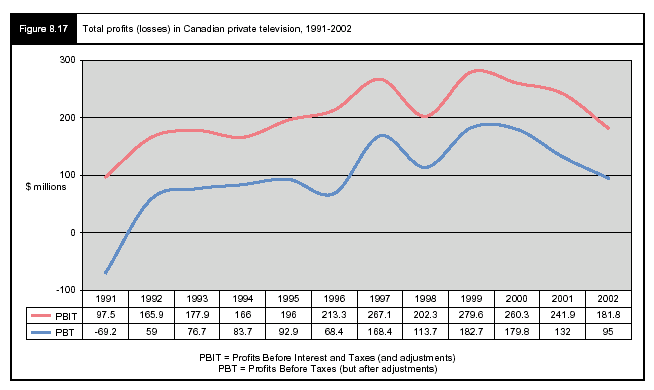 |
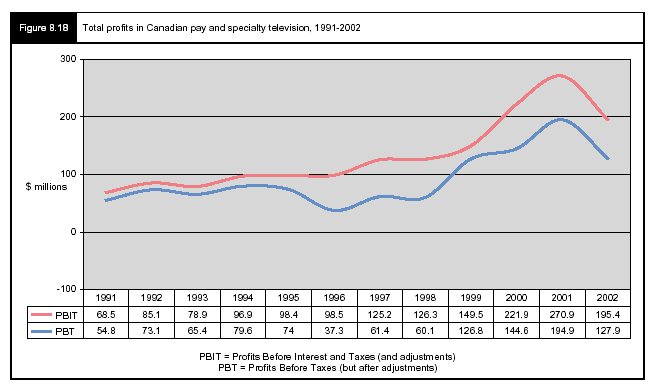 |
|
Eligible Expenditures on Canadian and Foreign Programming
Prior to 1 September 2000, Canadian private broadcasters were expected to spend a certain amount of their revenues on Canadian programming each year. This requirement was dropped by the CRTC on 11 June 1999 with the release of its new television policy. The justification for this change was as follows:
The Canadian broadcasting system has become increasingly competitive. In such an environment, licensees need flexibility and diversity to attract the largest possible audiences and advertising revenues. The Commission believes that, in a competitive environment, licensees require high-quality programming to win audience loyalty.
The Commission is concerned that the existing expenditure requirements are complex and may not provide licensees with the flexibility they require to adapt their programming strategies to a highly competitive marketplace. In addition, concerns regarding the equitable application of expenditure requirements have begun to outweigh the benefits.51
Figure 8.19 shows overall expenditures for the period 1997 through 2001 on Canadian television programming. All together, Canada's English-language private conventional broadcasters had average expenditures of about $400 million on Canadian content during this period. Meanwhile, Canada's English and French pay and specialty services, when combined, spent more than $500 million in 2002, which is double the amount spent in 1997.
What figure 8.19 also shows is that total expenditures on Canadian programming did not decline during the period 1997 to 2001. On the contrary, spending on the production of Canadian programming increased by about $450 million, from about a billion dollars in 1997, to more than $1.5 billion in 2001. However, as will be seen, there are notable variations among broadcasting categories. For example, expenditures by English-language pay and specialty services more than doubled between 1997 and 2001. At the same time, the expenditures of conventional services (French and English) experienced only moderate increases.
This growth is noteworthy when one considers that the international program production market has been contracting, with the collapse of Vivendi Universal, Germany's KirchMedia and Italy's Checchi Gori. Furthermore, the CFPTA notes that in the United States "consolidation amongst the networks and the major studios has led to an increase in in-house production that has depressed the market ... not just in the U.S. but internationally."52
|
|
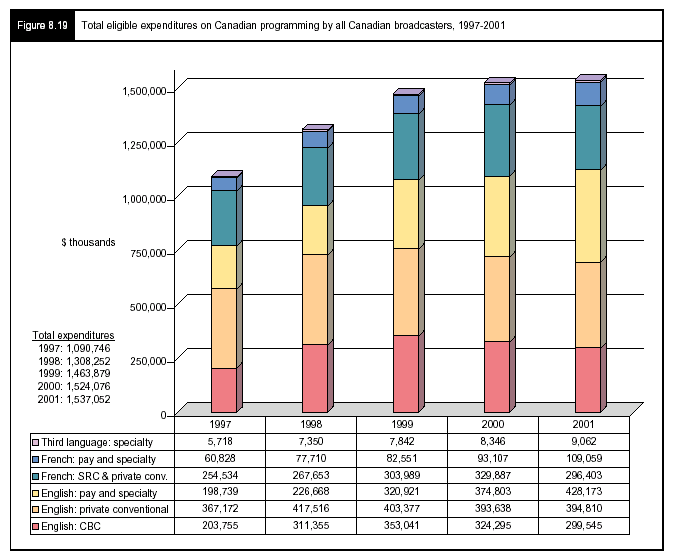 |
|
Figure 8.20 provides more detail on how money is spent by Canada's conventional broadcasters on Canadian content programming for English-language audiences. As can be seen, the private networks consistently spend around $225 million each year on news programming and about $25 million to $35 million on sports. As for drama and comedy programming, private conventional broadcaster spending fluctuated between $47 and $80 million.
|
|
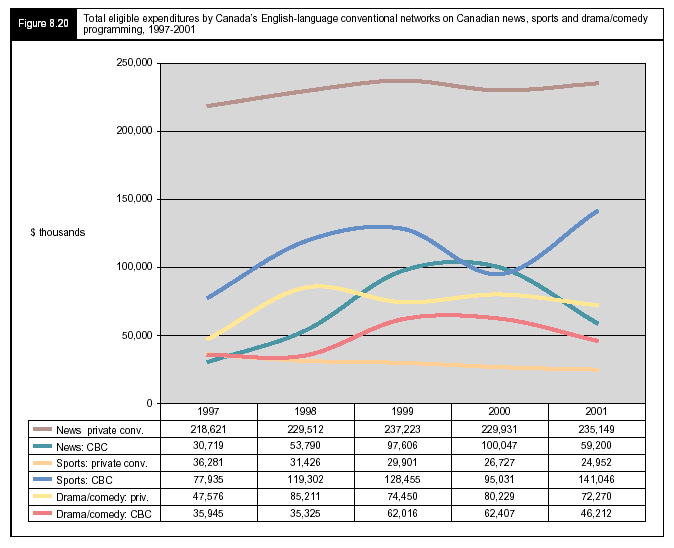 |
|
These fluctuations can in part be explained by national and international circumstances that have in recent times impacted the production and development cycle for Canadian television programming. As the Canadian Television Fund notes in its 2001-02 activity report:
Several factors contributed to a decrease in funding requests [in 2001-02], including fewer international sales, a shift by broadcasters into more non-dramatic programming, and big-ticket events like the 2002 Winter Olympics which filled up large portions of the prime-time schedule.53
Furthermore, as the Canadian Film and Television Production Association notes in its 2003 report on the state of the production industry, significant increases in expenditures may overestimate actual production of distinctively Canadian productions such as drama and comedy. As its report explains:
A review of data from past years suggests that productions with eight or more CAVCO points [i.e., distinctively Canadian productions] may obtain certification more quickly than other point categories. Productions with eight or more CAVCO points may have a greater reliance on tax credits, and therefore may submit their applications faster than other productions, and consequently receive certification more quickly.54
For these reasons, and others, expenditures on particular programming categories will inevitably vary from one year to the next.
|
|
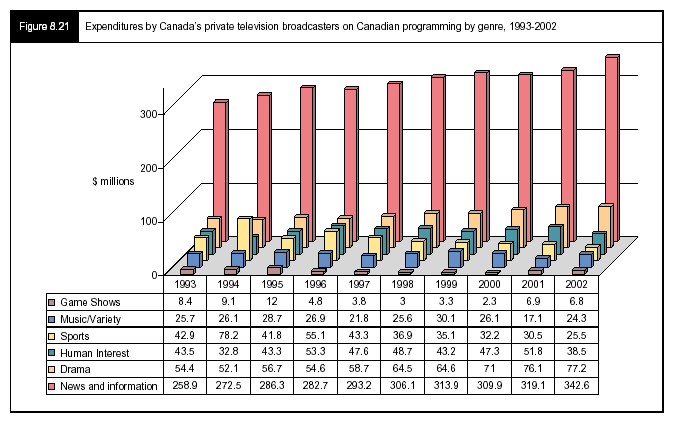 |
|
Canada's private broadcasters also spend money on foreign program acquisition. Figures 8.21 to 8.24 show the split between Canadian program expenditures and foreign programming for 1993 through 2002.
|
|
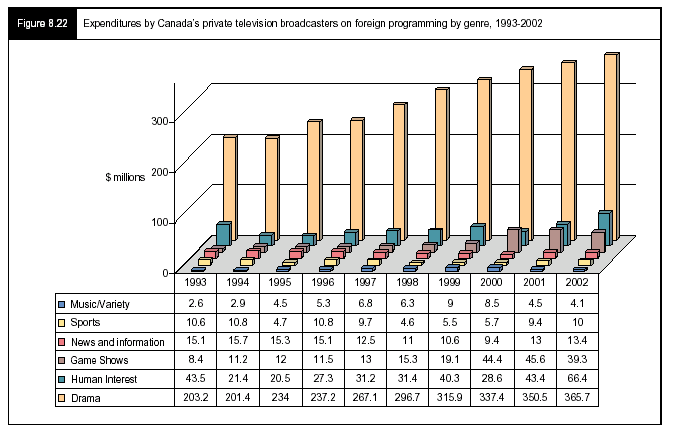 |
|
Figure 8.24 shows that spending by Canada's private broadcasters on programming increased by more than $300 million between 1993 and 2002, with the most notable increase being in the foreign drama category, where expenditures increased by more than $150 million (see figure 8.22).
It can also be seen that overall spending on Canadian programming increased by more than $83 million between 1993 and 2002, with increases in two important areas: Canadian news and Canadian drama (see figure 8.21). At the same time, there was a gradual decline in expenditures by private broadcasters on Canadian sports. These spending patterns also show that the relative weight on program expenditures shifted towards foreign programming between 1993 and 2002. Part of this shift may be explained by the increased cost of American programming and the gradual decline in the value of the Canadian dollar against the American dollar between 1993 and 2002. Whether this shift in spending says anything about the CRTC's new television policy (which is discussed in detail in Chapter 5), however, is extremely difficult to know without further analysis of the economics of Canadian programming expenditures.
|
|
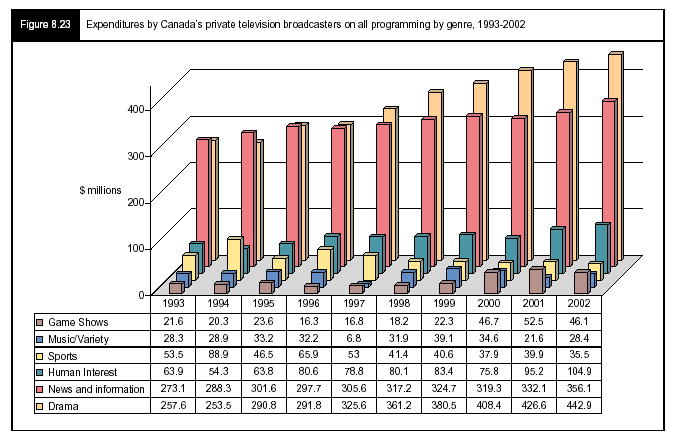 |
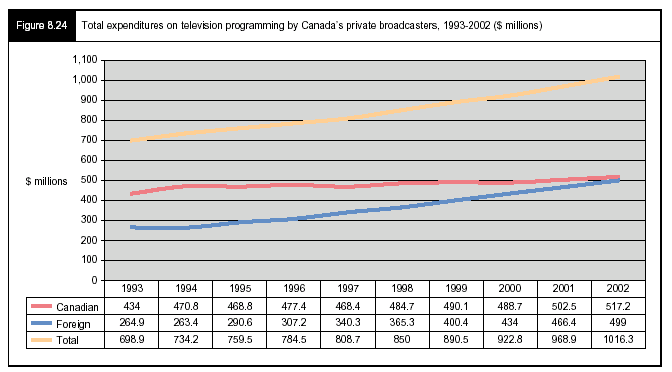 |
|
What the Committee Heard
In her appearance before the Committee, the Minister of Canadian Heritage made the following observation about the role of private broadcasters in the Canadian system:
Obviously, the notion of a private sector that is not profitable is not possible. Part of the challenge that we're going to have in looking at the whole system ... if you look at the past system, in a sense, when the original regulatory process gave licensing possibilities to certain television stations, they were basically able to feed their content requirements by selling advertising in the pre-direct-to-home world.55
The above quote captures well the core challenge that Canadian broadcasters face; that is, the need to remain economically viable in a changing environment, while living up to the various policy and regulatory expectations that shape our system. Witnesses raised a number of challenges related to this matter, many of which are discussed in other chapters.
| • | Chapter 5 discusses the economic challenges of producing or purchasing Canadian dramatic series. |
| • | Chapter 9 addresses the need for a new model to deliver local and regional programming to audiences. |
| • | Chapter 11 considers witness perspectives on vertical, horizontal, cross-media and foreign ownership issues. |
| • | Chapter 12 explains why a coherent plan is needed to steer the Canadian broadcasting system through the transition from analog to digital technologies. |
| • | Chapter 16 addresses the issue of Canadians who have opted out of the Canadian television system by subscribing to grey and black market satellite services. |
Two other issues raised by Canada's private television broadcasters were the long-term health of the private sector and the financial burden of Part II Licence Fees paid to the CRTC. These issues are discussed below.
The Health of the Private Sector
When the Canadian Association of Broadcasters appeared before the Committee, Mr. Glenn O'Farrell opened with the following comments:
A broadcast licence in a given market in this country was once a very valuable piece of property, as it meant access to a controlled marketplace. However, what we may have seen as a truth even a few decades ago is no longer the case as we face a new world. That new world has increased fragmentation, where a marketplace is flooded with more and more foreign and indigenous services than ever before. The new world has new technologies that defy a 40-year-old regulatory model. The new world is one of massive consolidation among key advertising customers. Broadcasting is experiencing a serious structural shift. As business people and as public policy makers, we need to work together to develop a response that will ensure success.56
For these reasons, argued Mr. O'Farrell, it is essential that the private sector be recognized as a component that is complementary rather than in competition with the public sector, particularly the CBC. He explained:
The public and private sectors must, in our view, be complementary, not competing. This already exists in radio, where a strong CBC radio service complements private radio. You can be in Halifax, Edmonton, or Chicoutimi, but when you tune in to CBC Radio, you know what you're listening to. They have a distinct programming voice, and we compliment those responsible for that.57
Several witnesses raised another important consideration. The ongoing viability of the private sector, particularly in English Canada, depends on the development of a star system, such as the one that has emerged in Quebec over the past two decades. Mr. Philippe Lapointe, Vice-President, Groupe TVA inc., illustrated this point with his account of the situation in French Canada today:
When we look at the 30 most-watched programs on television in French-speaking Canada, we find that 28 of them were developed, manufactured and produced by people who live here for people who live here. This is a significant success that we may take somewhat for granted. People think that it stands to reason.
However, when we look at the past ... we remember that in 1980-1985, French-speaking Canadians were watching mainly American programs: Mannix, Hawaii Five-0, Dallas and Dynasty. ... The most watched program in 1980-1985 was The Little House on the Prairie in its French version. Today, there are virtually no American programs on the French-language networks in Canada. People now watch programs made here.58
Thereafter, he outlined two reasons for this tremendous success story:
First, there was the will to make successful, popular programs that appeal to people. There is a way of doing television programming that is close to people, programs that talk about the stories that are very close to the people who live here. ... There are also other important structural reasons that account for this success. Among the top 10 programs this year, 8 would not have been possible without the participation of the Canadian Television Fund. The system in place for financing Canadian television is the cornerstone. Eight of the top 10 programs were financed with assistance from the Canadian Television Fund through its two programs, the EIP and the LFP. This is an essential ingredient of our success.59
All this being said, Mr. Lapointe went on to warn the Committee that the successes of French television are fragile. He pointed out that advertising revenues have declined sharply from levels previously enjoyed in a less fragmented market; furthermore, Canada's private broadcasters are very dependent on the level of financing available from production funds such as the Canadian Television Fund.
As for television in English Canada, several witnesses helped shed light on the burden that Canada's English-language broadcasters face. To put matters in perspective, Ms. Loren Mawhinney, Vice-President, Canadian Production, Global Television Network, made the following observations about the English-language market:
In the last five years we have experienced the launch of five more conventional channels and went from 20 speciality services serving Canadians to 60. Dozens of new diginets have launched this fall and their input is just starting to be felt. However, Canadians are not watching more television. As a result, the audience is simply becoming more fragmented; thus, so are the advertising dollars. It's becoming harder to afford high-cost programs as audiences are shrinking.60
Picking up on this same point, Mr. Alain Gourd, Group Executive Vice-President, Corporate, Bell Globemedia Inc., noted that the revenue model for television:
... which was based on advertising ... has now ... changed into a model based on subscriptions. At the moment, more than half of the overall revenue of the Canadian broadcasting system comes from subscriptions, and advertising now accounts for only one third of the overall revenue. This situation is exacerbated further by fragmentation; that is more Canadian channels are fighting over a single source of consolidated advertising.61
For these reasons, he predicted that:
If the trend continues, if we do not allow conventional, general television to have access to subscription revenue, we will be jeopardizing the future of the entire economic model for general television in French and in English, which is one of the main expressions of our culture.62
With these factors in mind, Mr. Gourd made the following recommendation:
... given the disappearing advertising market and the reduction in the absolute rate of funding from government, we must review ... the funding of Canadian programming production. ... the review could focus on an overall assessment of all sources of government funding — Téléfilm, the Canadian Television Fund, and tax credits — in order to develop an overall approach, an all-in-one hybrid.63
Taking this point a step further, Mr. Glenn O'Farrell, asked:
... that the Committee call on the Minister of Canadian Heritage and the Minister of Finance to strike a joint working group on the future of television program financing in Canada. We believe this is essential, and we call on you to make that recommendation so that we can find a long-term programming strategy for the financing of Canadian programming.64
Furthermore:
... we suggest it would be appropriate for the Department of Finance to streamline and simplify the tax credit system so it can be harmonized with provincial tax credit schemes. We believe an examination of the emerging economic issue of declining advertising dollars to find a subscription revenue stream for conventional television would also be appropriate.65
Part II Licence Fees
A request made by broadcasters (and distributors) repeatedly was that the Part II licence fees paid by the broadcasting sector be lowered.66 The following extract from the CRTC's 2002-03 Estimates, Part III Report on Plans and Priorities explains the rationale for broadcasting licence fees:
The CRTC collects fees under the authority of the Broadcasting Act and Telecommunications Act and the regulations made pursuant to these acts, namely the Broadcasting Licence Fee Regulations, 1997 and the Telecommunications Fee Regulations, 1995. ...
The Part I fee is based on the broadcasting regulatory costs incurred each year by the Commission and other federal departments or agencies, excluding spectrum management costs, and is equal to the aggregate of: the costs of the Commission's broadcasting activity; the share of the costs of the Commission's administrative activities that is attributable to its broadcasting activity; and the other costs included in the net cost of the Commission's program attributable to its broadcasting activities, excluding the costs of regulating the broadcasting spectrum.
The estimated total broadcasting regulatory costs of the Commission are set out in the Commission's Expenditure Plan published in Part III of the Estimates of the Government of Canada (i.e., Part III Report on Plans and Priorities). There is an annual adjustment amount to the Part I fee to adjust estimated costs to actual expenditures. Any excess fees or shortfalls are credited or charged to the licensee in a following year's invoice.
The Part II fee is calculated at 1.365% of a licensee's gross revenue derived from broadcasting activities in excess of an applicable exemption limit. The CRTC collects Part II fees on behalf of the government, with all revenues collected being deposited to the Government of Canada's Consolidated Revenue Fund (CRF). Consistent with the policy objectives outlined in the government's Cost Recovery and Charging Policy (1997) and as explained in the 1999 roundtable consultation with broadcasting fee payers, the rationale for assessing this fee is threefold:
...to earn a fair return for the Canadian public for access to, or exploitation of, a publicly owned or controlled resource (i.e., broadcasters use of the broadcasting spectrum); to recover Industry Canada costs associated with the management of the broadcasting spectrum; and to represent the privilege of holding a broadcasting licence for commercial benefit.
Figures 8.25 and 8.26 show the trend in licence fees, for broadcasters and telecommunications companies for the period 1983-84 through 2001-02.67 As can be seen, the private broadcasting sector paid $82.1 million in Part II fees in 2000-01, which even in isolation, was more than double the operating expenditures of the CRTC. In contrast, Canada's telecommunications sector paid just $18.7 million in licence fees in 2000-01.
In light of these comparative data, it can be understood why private sector broadcasters were asking the government to either lower or eliminate Part II licence fees. As Mr. Glenn O'Farrell explained:
... we ... face what we would call self-defeating pieces of public policy that impede success rather than favour success. An example of that is how the CRTC collects fees. The commission regulates both broadcasting and telecom. The licence fees for telecom are assessed on a cost-recovery basis, while broadcasting licence fees annually run almost $90 million over the CRTC costs. We believe this is a prejudicial tax that takes resources away from content.68
|
|
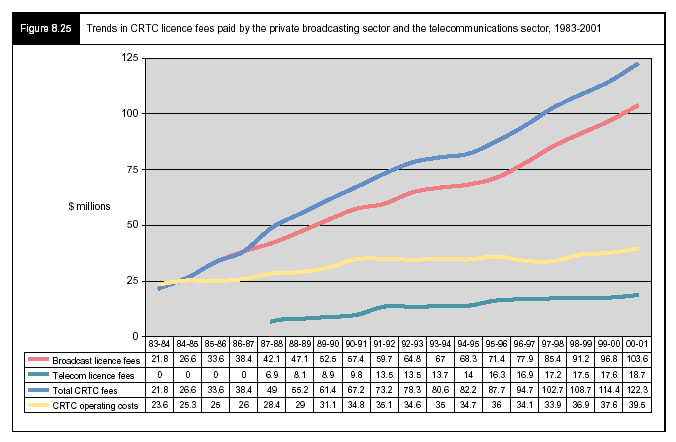 |
|
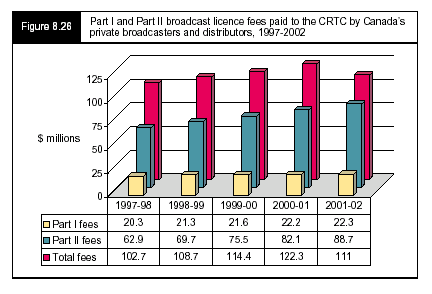
During Committee hearings, the CAB also suggested that the reduction or elimination of Part II fees would free up money for spending on Canadian content. For example, when a Committee member asked if the CAB would support a recommendation that the government allocate the money to the CTF or Telefilm, the CAB's response was:
... on the licence fee issue, that is not a revenue item but an expenditure item. Obviously that would fall directly to the bottom line of every broadcaster who would no longer have that expenditure to incur. That would free up those resources.
Certain broadcasters may choose to put that into local programming. Others may choose to put it into regional programming. Others may choose to put it into priority programming.
The problem ... with the fund is that it has limitations on the use of the funds for program types; and secondly, in fact it's producers who access the CTF, and not broadcasters.69
In short, broadcasters described their licence fee payments as "excessive" and used several arguments to back up this claim: first, the fees are far above the costs of operating the CRTC; second, they are a double tax; third, private broadcasters are subjected to other financial burdens (e.g., required benefits expenditures upon major ownership changes and the high cost to purchase or produce Canadian programming content).
Proposed Solutions
Overall, the Committee appreciated the testimony of the private television broadcasters and their commitment to the Canadian broadcasting system. In particular, the Committee applauds the successes of the French-language market and agrees that the initiatives undertaken to develop a star system have been extraordinarily successful. At the same time, it recognizes that these successes are delicately balanced and that they will require forward-thinking policies and programs if French-language Canadian programming is to enjoy similar successes in the years to come. |
|
As for the English-language television market, the Committee is concerned by its current situation. In particular, it is very worried that the existing programming model — which has become overly reliant on the cross-subsidization of Canadian programming through revenues generated by American programming — will eventually collapse. It was heartened, however, by the testimony of CAB representatives — both in hearings and in-sites visits across this country — that these broadcasters recognize that the future of English-language television in Canada depends on the production of high-quality productions that are made for Canadian audiences. Furthermore, the Committee was pleased to hear that the English-language market is working to emulate the star system developed in French-Canada as one strategy to help build audience size and loyalty for English-language Canadian programming.
With these considerations in mind, there are several issues that were raised by the private broadcasters where the Committee agrees that immediate action is required. While most of these points are dealt with in other chapters of this report, there are two that merit discussion here. These are: signal fees for conventional broadcasters and Part II licence fees. The next section discusses signal fees. Since cable and satellite service providers also asked for the elimination of Part II fees, this matter is discussed following the section on distribution.
Conventional Signal Fees
In the early decades of television broadcasting in Canada and the United States, advertising was the primary source of revenue for private broadcasters. Cable changed that by introducing subscriptions as an alternative revenue stream. The licencing of new pay and specialty channels also put pressure on the advertising-based business model of conventional television as viewers shifted their attention to these new services. The result of this, as noted in an earlier section, was that subscription revenues became more important than advertising revenues for the first time in Canadian television in 1991.
In parallel with the pressure on ad revenues due to audience fragmentation have been recent technological innovations, which have lowered the value of advertising on conventional networks. The most notable example is the personal video recorder (PVR), which allows viewers to skip through ads — or even eliminate them entirely.
Given these changes, it can be seen why conventional broadcasters are looking for new revenue streams. Some have purchased specialty channels, a move that gives the parent organization some subscription revenue; but the groups today — for example, CTV and its related specialty channels — have not regained the viewing share they once enjoyed in the days before fragmentation. This explains why conventional broadcasters believe they deserve a share of the subscription fees that are already collected for pay channels, specialty channels and the distant signals of conventional broadcasters.
The Committee recognizes that the broadcasting marketplace has evolved considerably since the early days of broadcasting and that the value of a conventional licence is not what it once was. That said, without further study of the consequences of such a fee on subscribers and on the broadcasting system as a whole, the Committee does not feel prepared to recommend immediate action in this area.
The Committee realizes that such a fee would have consequences for subscribers, but several Members noted that it is quite simply a matter of fairness. It is of the view, however, that conventional broadcasters — if such a fee were implemented — should be required to commit a certain portion of this new revenue stream to the production of high-quality, distinctively Canadian programming. The Committee also believes that such a fee, if implemented, should apply to the CBC. Indeed, this fee would represent a new revenue source for the Corporation and, by extension, would allow for the production or purchase of new Canadian programming.
E. Distribution
Broadcasting distribution undertakings (BDUs) play a key role in the Canadian broadcasting system, with over 9.3 million of Canada's 12.3 million households enjoying such services. As noted in Chapter 3, one of the first technological innovations used by broadcasting distributors was cable, which allowed for an increase in the number of available programming services. Introduced in London Ontario in 1952, cable distribution went through a phenomenal expansion between 1965 and 1975. By the end of that period, 60% of Canadian households subscribed to cable; by 2001, that figure had reached 71.9%.70
In 1997, the CRTC licenced Bell ExpressVu and Star Choice to offer direct-to-home (DTH) satellite service. These programming services are "multichannel services using high-powered satellites beaming digitally compressed signals receivable with small, fixed, 'pizza-sized' dishes."71 DTH satellite services were the first broadcasting companies that were allowed to compete with the cable distributors.
The emergence of digital signals is also having an important impact on the Canadian broadcasting system. Four types of broadcasting distributors offer digital transmission: cable operators, DTH satellite, telephone companies, and multipoint distribution systems72 (Look TV, Image Wireless Communications and SkyCable).73 Overall, there were 1,985 cable systems, two satellite service providers and 27 other distributors of television services in Canada in 2002.
Subscribers
The arrival of the DTH satellite distributors in 1997 ended the cable distribution monopoly in Canada. Figure 8.27 shows how rapidly DTH satellite service providers have established a foothold in the marketplace. Between 1998 and 2001, DTH market share increased from 2.6% to 16.2%. Meanwhile, cable dropped from a 97.2% share to 82.9%.
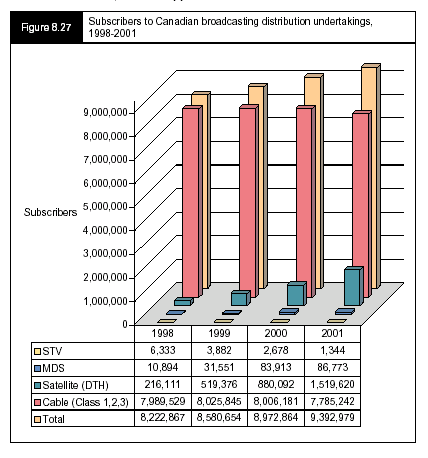
Ownership
Figure 8.28 shows the top six cable ownership groups in Canada. Overall, the top three (Rogers Cable, Shaw Communications and Vidéotron) dominate cable television distribution with a market share that accounts for more than three-quarters of all Canadian cable subscribers. Moreover, the top six have a market share of 93%.
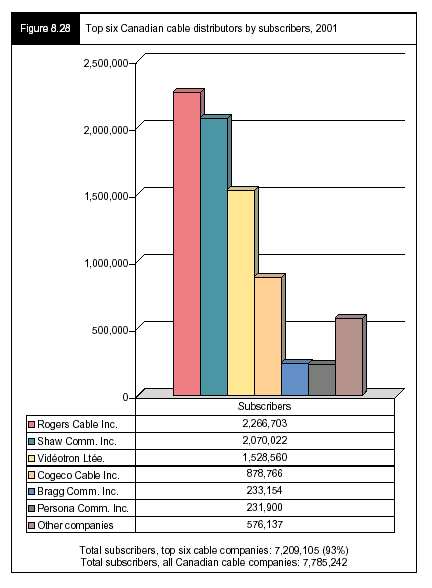
|
|
The Success of Star Académie
For nine consecutive weeks between late February and late April 2003, the program Star Académie broadcast by the TVA network once again confirmed the extraordinary appeal of popular television programs among viewers in Quebec. The runaway success of this series, whose ratings exceeded 50% of the Quebec population has never been seen in North America, or the rest of the world, for that matter.
The popularity of Star Académie is reminiscent of certain episodes of made-in-Quebec television series, such as Les Filles de Caleb, Blanche, Scoop, Lance et compte and La Petite Vie, which had similar ratings. Quebec's infatuation with its performing artists is well known; however, in the case of Star Académie, the 14 members of the "Académie"; that is, the stars of the show, were initially unknown to Quebec viewers. It is also interesting, if not surprising, that the winner of the competition, as chosen by Quebec viewers, was Wilfred LeBouthillier, a native and resident of Tracadie-Sheila in New Brunswick. Will he follow in the footsteps of Roch Voisine?
Star Académie is not a new television format. On the contrary, numerous similar formats have been espoused by the American and European networks in recent years. While the formula itself was not new, the viewer ratings achieved by TVA, certainly were. Nothing even vaguely resembling the ratings achieved in Quebec has ever been achieved in the United States or Europe.
An article written in the 26 April 2003 edition of La Presse, under the byline of Hugo Dumas, asked the question, "How did this happen?" Mr. Dumas reported that [translation] the Star Académie tornado had blown the audience monitoring device, and that record sales have been swept away." The article written by Mr. Dumas contains figures that say a lot about the nearly unprecedented success of Star Académie. Approximately 60% of the television viewers who followed the series were female, and about 20% were under the age of 25. Viewers between the ages of 35 and 54 accounted for 36%, while those 55 and older accounted for 30% of the viewership. According to a survey conducted by Impact Recherche, one in two Montrealers watched Star Académie.
The members of the "Académie" recorded an album of the songs they sang during the series. Some 500,000 copies of the album were shipped to stores. It is estimated that approximately 400,000 copies have been sold to date. In April, Star Académie was the most listened to album in Canada, beating out Céline Dion, Norah Jones, Avril Lavigne and Linkin Park.
A number of factors contributed to the outstanding success of Star Académie, in particular, the obvious talent of the participants, and the professionalism and "magic touch" of Julie Snyder, the host and producer of the show. Broadcasting this upbeat program, in which singing reigned supreme, during a worrisome period marked by the war in Iraq and the outbreak of Severe Acute Respiratory Syndrome (SARS) proved to be a wise move that most likely contributed to the warm reception it received from the public.
|
|
CTV and The Juno Awards
In April 2003, international mega-star Shania Twain greeted a sold out crowd at the Corel Centre in Ottawa-Gatineau. Emerging as host of The 2003 Juno Awards, her mere presence alone symbolized, that, like herself, the Junos had skyrocketed to the big time. In fact, The Juno Awards has fast become the hottest Awards showcase in Canada, and on that night, you could literally feel the electricity in the air. By the time the show was over, 17,000 screaming fans had witnessed one of the most exhilarating, star-studded nights in Canadian music history. Across the country, the broadcast had captured an astounding 2.2 million viewers, 53% more viewers than the preceding year and incredibly, more viewers than either the Grammy Awards or the American Music Awards in Canada. In just two short years, CTV had not only turned The Juno Awards around, but also repositioned it as the jewel in the crown of music awards shows in Canada.
CTV's strategy for a successful Juno franchise relied heavily on an integrated on-air promotional campaign tied in with a national public relations campaign. The Junos became the Network's top priority and viewers noticed. With a three-month lead-in window, Canadians saw fresh, creative, original campaigns across the country. CTV's news and entertainment properties — including CTV News, morning star Canada AM, late night hit Open Mike with Mike Bullard and daytime entertainment stalwart eTalk Daily — each supported the Juno Awards broadcast with their own on-going, extensive coverage. CTV's on-line partner Sympatico, teamed up to offer high speed subscribers exclusive Web-casts of Juno-nominees in concert. The CTV promotions team developed multi-regional and national contests, partnering with The Globe and Mail, who also provided coverage of the Junos themselves.
CTV's approach was based on the previous year's success story that saw the Juno Awards exported to Canada's East Coast for the first time. CTV's The 2002 Juno Awards from St. John's, Newfoundland pulled the show out of a three-year ratings slide with the help of hosts the Barenaked Ladies and a performance lineup that would make any Grammy Award producer envious. Canadians tuned in to a refreshingly energetic, youthful and star-studded Juno Award broadcast to the tune of 1.4 million viewers — a 24% leap from the previous year. Close inspection of audience data revealed that audiences were younger than ever before.
The incredible success of the past two Juno Awards broadcasts by CTV demonstrates that it is possible to attract large audiences to Canadian entertainment programming. CTV plans to build on these successes for its next broadcast of the Awards in 2004. |
|
|
Revenues and Profits
Figure 8.29 shows that there has been a steady and strong growth in BDU revenues over the past few years. Between 1998 and 2001, revenues increased from about $3.1 billion to more than $4.5 billion, representing a 50% increase in just four years.
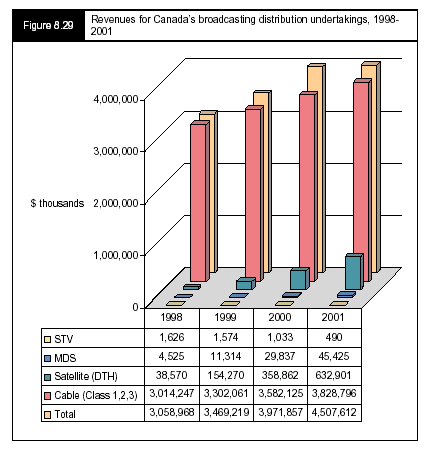
Revenue figures by themselves, however, can be misleading. Figures 8.30 and 8.31 present two measures of the profitability of distributors. For the large cable distributors, profitability, as indicated by the most commonly used measure, the margin on profits before interest and taxes (PBIT %), has declined since 1998. This decline is even greater if allowance is made for the large interest payments made by the capital-intensive cable industry and the margin on profits before taxes (PBT %) is used.
|
|
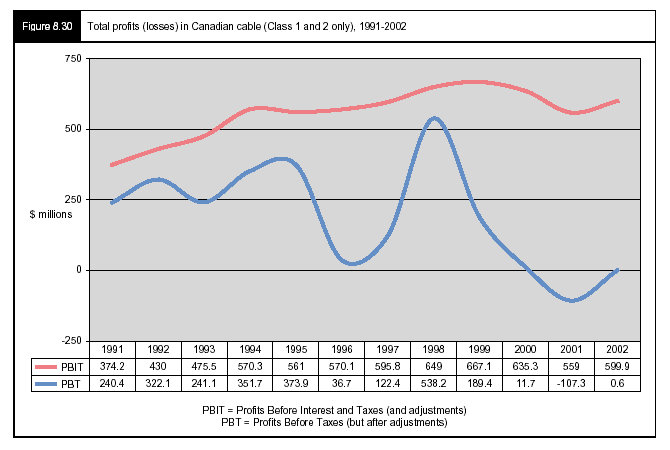 |
|
Another measure of profitability for cable — not shown in the figure — is the return on average net fixed assets. This, too, has declined since 1998, going from 20.59% in 1998 to 10.64% in 2002. Part of the reason for decreasing cable profitability has been the increased competition from alternative distribution services, primarily satellite (DTH). Canada's DTH services, due to the large capital expenditures required to launch their services, have yet to show any profit.
|
|
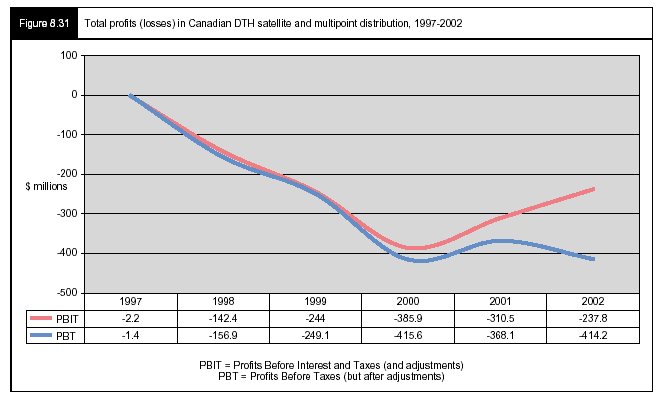 |
|
What the Committee Heard
As noted earlier on, there are nearly 2,000 cable distributors and 2 large satellite distributors in Canada. There is also Telesat Canada, a satellite, communications and systems management company. The main issues raised by these groups included: the recognition of competition and consumer choice as principles in the Broadcasting Act; regulatory inequities; a recognition of the challenges facing small systems; the cost of capital; and legislative change to respond to the grey and black markets.
Cable Industry Concerns
In her appearance before the Committee, Ms. Janet Yale, President and Chief Executive Officer of the Canadian Cable Television Association (CCTA), highlighted the size and importance of the cable industry in Canada:
The cable industry has played an important part in the success of the Canadian broadcasting system. The (...) large and small licensed cable systems active in cities and towns in every part of this country now serve approximately 7.6 million households. Cable television is received in more than 70% of homes passed by cable throughout Canada.74
Ms. Yale also pointed out the extent to which the cable industry has been making an investment in Canada's communications and new media infrastructure:
The industry investment in digital cable and high-speed broadband services is significant. As an industry we spend an average of 1 billion dollars annually on capital expenditures. ...
The result of these investments is that our advanced infrastructure now reaches more than 75% of Canadian homes passed by cable, including urban and rural areas, and giving Canada the enviable position of being one of the most connected nations in the world. Through our investments, we built a broadband network that can provide 7.9 million households with access to digital cable and to cable high-speed Internet service. We serve today approximately a million digital customers and 1.5 million Internet customers. Looking to the future, we're already building the digital platforms for the next generation of services.75
But the provision of cable and Internet service does not come without costs to customers. In this regard, Ms. Yale made the following point:
Let me clarify. We pay for the services we carry. The cable industry collects the fees, and they get distributed back to the programming of services. As we pointed out in our presentation, the vast majority of the revenues that those programming services receive is from cable subscription fees, not from advertising revenues.
So you have to think of cable rates as really a collection of payments to a series of programmers who we carry, and if you factor in that all the new services are services for which we have to pay the fees for carriage, and if you look at the authorized rates for those services, that accounts for the increase. It's a value-for-money equation. What you pay for is certainly not what you got 10 years ago.76
Moving on to more specific challenges, Ms. Yale, echoed many of the same arguments made by Canada's private broadcasters concerning the CRTC's Part II licence fees. Part II fees, in the view of her industry, she argued, go well beyond what is required to cover any administrative costs. Moreover:
... we already pay ... taxes. I'm not sure what taxes you think we don't pay. There are municipal taxes and income tax ... it's not as if the industry is subject to any lesser a degree of taxation than any other industry in this country. ... over and above that, we pay the costs of regulation. The entire costs of operating the CRTC, both in telecommunications and in broadcasting, are recovered from the parties that appear. All the licensed undertakings pay in the [P]art I fees the direct costs of regulation.77
For these reasons, it was the position of the CCTA that:
[P]art II fees, which generate a great amount of money, which are not directly related to the costs of regulation. ... could be better spent by the companies on issues such as fighting the black market, infrastructure investments, community programming, and so on rather than being a general contribution to the Consolidated Revenue Fund over and above whatever other taxes we pay. That money should no longer be collected in the [P]art II fees. 78
A second issue raised by the cable industry concerned a practice known as time shifting.79 As Mr. Dean MacDonald, Senior Vice-President, Rogers Communications Inc., told the Committee:
Time shifting is part of the milieu of product offering right now. The biggest difference between cable and satellite is really more in regulatory packaging and linkage rules. The satellite people have more flexibility in terms of how they can package the product to customers versus how cable can. It's certainly something we'd like to see levelled.
For instance, to put it in magazine jargon, a satellite customer can go in, pick a magazine, and leave the store, whereas in some instances when the cable guy goes in to buy a magazine, he can't leave the store without buying another magazine. It's an imbalance we would like to see changed... 80
A third issue (which is discussed in more depth in Chapter 11) was the need for foreign capital to finance the growth of the infrastructure. As Mr. Yves Mayrand explained:
... we completed a very major financing. It was the equivalent of over $410 million Canadian. That financing was essentially required to support our capital investment programs in building the infrastructure. This is expensive hardware we are talking about here. It is wiring direct to the home, pushing down fibre, putting in two-way, adding complex electronics, and interconnecting all these systems. ...
That is very expensive. It requires investment. Our industry is capital hungry. If we look at what is available in terms of pools of capital in this country, I can tell you, just by way of example in our case, that we just could not have arranged that financing in the Canadian market last fall. Not possible. We explored that possibility, but it was just not there.81
Finally, a fourth issue raised by the cable industry was the survival of the smaller cable companies. The value of these smaller systems to the overall health of the industry was explained to the Committee by Mr. Dave Baxter, the President of WestMan Communications Group, in the following way:
Small cable systems in Canada provide service to less than 10% of Canadian homes, but provide tremendous leverage for achieving Canadian cultural objectives. Viable small cable systems that can compete and diversify will be in a position to continue serving rural areas with community programming, high-speed Internet access, and other future interactive services.82
He further noted that companies such as his take:
... particular pride in the high level of community-based programming it provides through a substantial funding commitment and the commitment of volunteers. We have extended community programming to 19 communities, even though we're only required to provide community programming to our two largest communities.83
That being said, Mr. Baxter highlighted a number of challenges for smaller systems. These include: geographic remoteness, small customer base, smaller cable network capacity, capital and financing requirements, government regulation, and competition with legal and illegal satellite services. Furthermore:
If television broadcasters continue to abandon rural areas or increasingly deliver urban-based programming to these areas, the importance of local community programming will increase to fill this void. Being able to sell advertising on the community channel as well as on "ad avails" would help small cable operators to maintain their financial ability to continue, and perhaps strengthen, their community programming focus.84
In short, it was the view of Mr. Baxter that:
The situation for small cable operators is very tough, and some operators are even curtailing or shutting down their operations, leaving satellite as the only distribution choice for these customers. In order for small cable systems to remain viable, they need to be competitive and to diversify. For this to happen, a regulatory framework that facilitates sustainable competition in rural areas is needed for both broadcast distribution and telecommunications.85
For these reasons, he argued that there is a pressing need for greater regulatory flexibility if smaller cable companies are to survive. In particular, there is a need for:
... more signal packaging and pricing flexibility in order to be able to compete. For example, the requirement for smaller cable systems to carry signals on a mandatory basis hampers their financial ability to remain competitive so we can continue to expand our services, including community programming and high-speed Internet.86
In light of the above challenges facing the cable industry, the CCTA made the following policy proposal to the Committee:
In this environment, the policy objectives of Canadian content and programming diversity don't lose their importance. ... Few would dispute the benefits that competition has brought to the broadcasting system and to Canadian consumers. These benefits include greater choice, diversity and funding for Canadian programs. ...
The ultimate success of the Canadian broadcasting system and the satisfaction of consumer demand are intrinsically linked. Canadians ... are increasingly demanding the ability to choose what they want, when they want, and where they want. The Broadcasting Act must be updated to reflect this new reality. Therefore, CCTA recommends that competition and consumer choice be incorporated expressly into the policy objectives of the Broadcasting Act.87
Satellite Service Provider Concerns
Mr. David McLennan, President and Chief Operating Officer, Bell ExpressVu, characterized Canada's satellite service industry in the following manner:
Since the launch of Bell ExpressVu and Star Choice a little over four years ago, the two companies have grown very rapidly. In total, the two companies have almost 2 million subscribers, representing just about 15% of the TV households in Canada. Bell ExpressVu itself has a little over 1.1 million subscribers. To make this happen, the shareholders of both Bell ExpressVu and Star Choice have made considerable investments totalling more than $2 billion.88
And these investments, argued Mr. McLennan, have made a significant contribution to the transition from analog to digital technologies. In this regard, he noted that without direct-to-home satellite services:
... digitization would have seen a much slower rollout across the country. Right now, the two satellite providers have about a 65% market share of the digital subscribers in Canada. As a result of this, customers, programmers, and the broadcasting industry as a whole have enjoyed significant benefits.89
That said, Mr. McLennan was quick to note that it remains to be seen whether DTH satellite can be economically viable in the longer term. He observed that despite:
... growth in the marketplace, the financial viability of DTH requires substantial scale, and we're not quite there yet. Obtaining scale is challenging in a country the size of Canada, with only 12 million TV households and a market dominated by cable.90
For this reason, like his cable industry counterparts, he urged that there be:
... a stable regulatory framework. Otherwise, it becomes very difficult to attract the kind of investment we need and to make the kinds of business investment decisions that we need to make in order to move forward and achieve critical mass.91
Furthermore:
... given the challenging economics that we all face, regulatory financial obligations need to be examined. Specifically, those that do not advance the Canadian broadcasting industry should be eliminated. Here, I'm specifically referring to the part II licence fees, something I believe you've heard about from the Canadian Association of Broadcasters and the CCTA.92
He explained:
... funds such as the funds now being used for part II, along with other similar kinds of resources, could be better deployed into investments that continue to evolve our product and allow us to bring innovative services that add to the broadcast system.93
Telesat Canada, a wholly owned subsidiary of BCE Inc., also appeared before the Committee. Created through a 1969 Act of Parliament, Telesat launched the world's first commercial domestic communications satellite placed in geostationary orbit, the Anik A1 in 1972. It is a leader in satellite and communications and systems management. As Mr. Paul D. Bush, Telesat's Vice-President explained:
To quantify our involvement in the Canadian broadcasting industry, I have a couple of facts to leave you with. As I mentioned, 95% of the broadcasting signals in Canada are delivered on the Anik and Nimiq satellites. Our facilities deliver both to cable and to DTH, and with 8.5 million cable households and the almost 2 million DTH households, that pretty well equates to the one-in-ten rule observed in the U.S....
Our satellites and our teleport infrastructure provide essential services for the national broadcasters, CBC, Global, and CTV. They also provide essential services into northern communities. In many instances in Canada, due to our landscape and our population distribution, getting fibre and different types of facilities in is obviously very difficult. Satellite bridges that gap, and the broadcasters use 70% of our satellite capacity.94
Mr. Bush also noted that Telesat operates in a global market and that Canadian regulations make it less competitive with non-Canadian companies:
... While Telesat operates in a liberalized WTO environment, we're subject to more policy objectives, greater regulation, and significantly higher regulatory fees than our competitors. As an example, we pay annual licence fees to use the orbital slots in Canada. For Nimiq — and this is directly flowed back to the broadcasters — the licence fees are $2.1 million per year, while the equivalent licence fees for an American DBS operator are $100,000 per year. So there are significant differences in the fees that we pay versus those paid our competitors.95
For this reason, he urged that telecommunications and broadcasting objectives and regulations be coordinated. He also urged that something be done about the grey market and black market satellite services in Canada as its numbers suggest that licenced Canadian satellite services could be losing $20 million to $30 million a month because of this problem.
Proposed Solutions
Many of the issues raised by distributors are dealt with in other chapters of this report. For example: Chapter 9 makes several recommendations concerning the need for a uniform policy framework for the distribution of programming services by cable and satellite; Chapter 9 also makes several proposals that would help smaller cable companies fund and augment the provision of certain programming services; Chapter 11 makes a recommendation concerning foreign ownership; Chapter 16 talks about the grey and black satellite market; and, Chapter 19 makes several recommendations designed to better coordinate broadcasting and telecommunications policy. The issues of competition and consumer choice, satellite licence fees, and Part II licence fees are discussed below.
Competition and Consumer Choice
The Committee sympathizes with the concerns of Canada's smaller cable operators. It notes that several members visited a small cable co-operative — Access Communications — during their visit to Regina and were told first hand how difficult it has become to provide service of equal quality to those services offered by Canada's larger BDUs. For this reason, the Committee appreciates why smaller cable operators have asked for greater flexibility in signal packaging and pricing, and understands why the CCTA has proposed incorporating the concept of "competition and consumer choice" as a policy objective of the Broadcasting Act.
The Committee notes, however, that the Broadcasting Act already includes a provision, which states that private broadcasters should be "responsive to the evolving demands of the public." In the Committee's view, this particular principle is an implicit recognition of competition and consumer choice. Indeed, the very notion that the private sector is included in the Act is a de facto acknowledgement that competition and consumer choice are recognized — and expected — to be part of the Canadian broadcasting system.
Satellite Licence Fees
On a related point, the Committee was troubled to learn that Canada's satellite companies feel that they pay annual licence fees for orbital slots that are disproportionate when compared with the rates paid by their American counterparts, with whom they are in competition. The Committee recognizes, however, that it would be premature without further study to take a position on this particular matter; moreover, this question falls outside the mandate of this committee's study. Accordingly, the Committee is of the view that the federal government should undertake a study of such fees to ensure that an undue burden is not being imposed on Canadian satellite companies, which might, by extension, be impeding their capacity to compete internationally.
RECOMMENDATION 8.3:
The Committee recommends that the appropriate department study the annual orbital slot licence fees charged to Canada's satellite companies to ensure that they do not place an unreasonable burden on the capacity of these companies to compete internationally. |
If a decision is made to significantly reduce these fees, a reasonable portion of any savings should be passed on to broadcasters, distributors and consumers.
Part II Licence Fees
After considerable deliberation, the Committee has concluded that there are valid reasons to question the intent and purpose of Part II licence fees. It is concerned that these fees may constitute an additional tax (or levy) that has been imposed on both broadcasters and distributors. As discussed above, there are rationales for the Part II licence fees based, in part, on the value of the spectrum to broadcasters and the privilege of holding a broadcasting licence for commercial benefit.96 In the light of technological advances and fragmentation these rationales may be weaker today than in the past. Furthermore, the Committee notes that the Minister of Canadian Heritage is on record as having suggested that these fees need to be reviewed.
The Committee is also aware that total licence fees paid by broadcasters — Part I and Part II — have risen much faster than prices since the last revision of the Broadcasting Act. These fees are now much higher than the cost of operating the CRTC and much higher than the licence fees charged to telecommunications companies.97 The Committee, however, does not feel it would be prudent to simply recommend the elimination of Part II fees at this time. It is of the view that this matter requires serious analysis by the Department of Finance and the Treasury Board to determine the rationale and fairness of these fees. For this reason:
RECOMMENDATION 8.4:
The Committee recommends that the Department of Finance and the Treasury Board, in conjunction with the Department of Canadian Heritage and the CRTC, study the rationale and fairness of Part II licence fees that are currently charged to broadcasters and distributors with a view to their elimination if found to be discriminatory. The results of this study should be reported to Parliament within one year of the tabling of this report. |
The Committee realizes that the eventual elimination of Part II fees may be a matter of fairness and would not automatically compel Canada's broadcasters or distributors to commit more money to the Canadian broadcasting system. On the other hand, the Committee is concerned about the need for additional revenue sources that contribute to Canadian programming. As such, it feels that at least some portion of these monies could and should be redirected into the Canadian broadcasting system, particularly for the production of high-quality Canadian programming. For this reason, the Committee believes that the CRTC could negotiate commitments from broadcasters and distributors to reinvest money into the Canadian broadcasting system should these fees be eliminated at some point in the future. With this in mind:
RECOMMENDATION 8.5:
If it is determined that Part II licence fees should be eliminated or reduced, the Committee recommends that the CRTC, in consultation with the Department of Canadian Heritage and relevant broadcasting industry stakeholders, be encouraged to develop a plan for the reallocation of all or a portion of the former value of Part II fees back into the Canadian broadcasting system. |
For example, these monies could be used to support the creation of original and distinctively Canadian programming, the digital transition, or could be directed into the proposed Local Broadcast Initiative Program, for community, local and regional programming partnerships (see Chapter 9).
F. Advertising
Throughout its history, private broadcasters have depended on advertising. With the growing importance of cable in the 1970s and 1980s, and satellite and digital services today, subscription revenue is now playing an ever-increasing part in the broadcasting business model. Recent technological advances have placed added pressure on the advertising-based business model. Still, advertising is critical to today's broadcasting system.
Figure 8.32 shows the extent to which advertising is important for television and radio. As can be seen, in 2001, advertising revenue for all Canadian media was worth about $7.6 billion dollars, of which $3.5 billion was generated by television and radio.
As noted earlier on, the two main strands of broadcasting revenue are advertising revenue and subscription revenue. Private radio broadcasters and private conventional television broadcasters rely on advertising revenue. In 2001, ad revenue made up 98 % of total revenue for radio broadcasters and 94% for conventional television broadcasters.98 Pay and specialty broadcasters also garner advertising revenue. In 2001, advertising revenue was $438 million, which was about 29% of their total revenue. The bulk of revenue for pay and specialty broadcasters comes from subscription revenue, which is passed on from the cable and DTH companies. BDUs receive almost all of their revenue from subscription fees.99
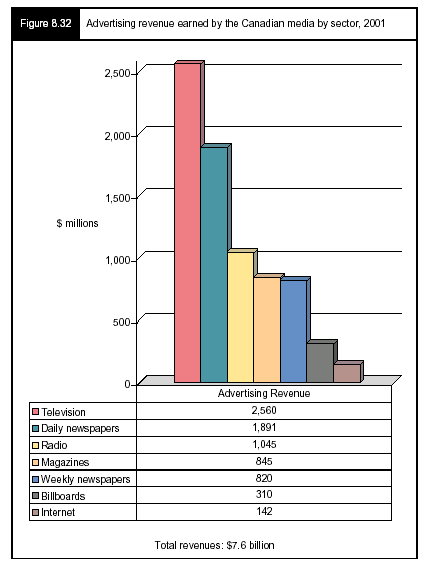
Broadcasters face many competitors for advertising revenue. Changes in the number or type of competitors, however, can have an effect on an individual seller of advertising. For example, the growth of pay and specialty services took some revenue away from conventional broadcasters (and from other media).100 But more television channels does not necessarily mean that television's share of media advertising will automatically grow. Fragmentation leads to smaller audiences for any one channel — the conventional networks can no longer deliver a third of television viewers — and advertisers may prefer advertising in a magazine whose readers share certain characteristics.101
An added complication is that satellite technology allows viewers in western regions to see certain American programs before their regularly scheduled timeslot. This has consequences for advertising revenue for Canadian broadcasters. The show Friends, for example, may be scheduled for 9:00 p.m. EST on a Toronto station and 9:00 p.m. CST on a Winnipeg station. Since satellite subscribers in Manitoba may receive programming from the Toronto station as well as the Winnipeg station, they are able to watch Friends one hour earlier. Both the Toronto broadcaster and Winnipeg broadcaster will be able to request simultaneous substitution of its ads for those on the U.S. channel showing Friends at the same scheduled time. This means that satellite viewers in Manitoba who choose to watch the earlier showing of Friends see the ads from the Toronto broadcaster. If there were a large number of Manitobans watching the earlier showing of Friends this could increase the value of non-local advertising on the Toronto station, and could decrease the value of local advertising on the Winnipeg station.
Technological change may also affect television advertising in other ways. For example, personal video recorders (PVRs) allow a viewer to bypass commercials, either by not recording them or by skipping ahead while watching a recorded show. Also, some VCRs now have buttons on their remotes that advance the tape in thirty-second intervals. The result, of course, is that broadcast ads, which may not get watched, lose their value. On the other hand, technology could make television advertising more attractive by allowing interactive TV (iTV) or targeted ads based on the profile of programs watched.
Several groups that appeared before the Committee raised issues to do with advertising in the Canadian broadcasting system. The Association of Canadian Advertisers, for example, emphasized the importance of advertising revenues to the Canadian broadcasting system:
Advertising is also the primary resource sustaining the Canadian broadcasting system. Net advertising media spend was estimated to represent $10.3 billion in revenue flow to Canadian media companies last year. Of this amount, approximately $2.5 billion is invested annually in television advertising and about $1 billion in radio advertising. ... over half of all the revenues to support broadcasting coming from advertising, and it makes advertising the single largest contributor of funds to the Canadian broadcasting system.102
The Association also called for more opportunities for Canadian advertisers in the Canadian broadcasting system:
Advertising makes a significant economic contribution to our country. Advertising pays for the content, the shows that entertain and inform Canadians. As such, it is important that it remain an effective marketing tool for advertisers — competitive, uncluttered, and efficient. Accordingly, we support universal access to broadcasting and choice. We advocate that any and all newly licensed services should be advertising supported. Finally, we propose that an advertising-supported CBC Radio could greatly benefit that service, as well as the Canadian taxpayer.103
The Alliance for Canadian Advertising Tax Credits (ACATC), in addition to being concerned about maintaining the role of advertising in the Canadian broadcasting system, raised the point that Canadians are producing fewer commercials for Canadian television:
While statistics are hard to come by, the industry estimates that when we entered the 1990s we produced here more than 80% of the commercials broadcast by Canadian television stations. By the end of the decade that had fallen to 50%. But there's more to that figure than just an overall decline. Since commercials for governments — still the largest advertisers in the country — banks, beer, and others are country-specific products and services, those commercials are all produced here. When you isolate consumer products and services, automobiles and so on, you see that virtually all these commercials are imported, a substantial change from a decade ago.104
To address this perceived problem, interested parties have formed an ad hoc coalition: the Alliance for Canadian Advertising Tax Credits. This group noted the economic and cultural importance of Canadian advertising. It also pointed out that Australia has addressed a similar problem by obliging broadcasters to show a certain percentage of Australian-produced commercials. That said, ACATC preferred a tax credit approach:
... with a small amendment to the existing tax credit system you could provide an incentive for those who produce television commercials in Canada equivalent to the credit available for producers of television programs and movies. While there would need to be appropriate regulations for productions that are much smaller than a movie or a television show, we think it might work.105
In a presentation before the Committee, Mr. Alain Gourd, Executive Vice-President with Bell Globemedia, also commented on the changing role of advertising in broadcasting. He said:
The first change had to do with the source of revenue of the Canadian [t]elevision [s]ystem. This revenue model, which was based on advertising at the time, has now been changed into a model based on subscriptions. At the moment, more than half of the overall revenue of the Canadian broadcasting system comes from subscriptions, and advertising now accounts for only one third of the overall revenue. This situation is exacerbated further by fragmentation; that is more Canadian channels are fighting over a single source of consolidated advertising.
If the trend continues, if we do not allow conventional, general television to have access to subscription revenue, we will be jeopardizing the future of the entire economic model for general television in French and in English, which is one of the main expressions of our culture.106
Finally, Mr. Dean Butler, Director, Media Services and President, Vancouver Media Directors Council, raised the point that fragmentation and the availability of national networks on cable and over satellite has changed the traditional local market for broadcast advertising. He claimed that it is increasingly the case that broadcasters sell advertising for a national market, and that this advertising is being priced too high for local merchants. As a result:
... it's becoming very difficult to operate on a regional basis in the face of that kind of competition. It definitely favours national perspectives, national interests and it goes against supporting any sort of regional economy. I don't believe the regional TV stations can operate in that environment and eventually I believe the local television stations like CKBG, Prince George, which is a CBC affiliate, will find itself being a repeater only because they will not be able to sell advertising on a local basis. So from an economic perspective, the local markets have really lost the advantage of having a television station in their own market.107
Mr. Butler also provided a personal example of how the advertising costs in his region of British Columbia have increased in the past decade:
I ... bought television advertising in Vancouver 10 years ago at a cost of $100 a point, 200 points, it's $20,000 a week. Today to buy that same TV, it's going to be $500 a point ... It's increased 10 times, so that would be $200,000 for that same air time. It's gone up 10 times in 10 years.108
Finally, Mr. Butler noted the significance to Canadian merchants — those who would want to purchase advertising time from broadcasters — of concentrated ownership, with possible foreign control, in the advertising industry:
In our own industry we are facing huge consolidation of ownership among advertising agencies. Now there might be four or five major agencies in Canada that are essentially controlled out of New York. I have been told point blank that I cannot fight New York. Our industry is being decimated by concentration of ownership, not only within the media, across media, but within advertising itself. Anything we can do to create greater competition is a better thing for our country and especially for our region in British Columbia which, from an advertising perspective, we're in danger of losing control of.109
In short, broadcasters and advertisers highlighted the competitive pressures they face in today's highly fragmented market. Indeed, in its 1999 television policy the CRTC stated that:
The Canadian broadcasting system has become increasingly competitive. In such an environment, licensees need flexibility and diversity to attract the largest possible audiences and advertising revenues. The Commission believes that, in a competitive environment, licensees require high quality programming to win audience loyalty.110
With this in mind, the next section makes some proposals, which the Committee believes would help industry stakeholders deal with these competitive pressure.
Proposed Solutions
Tax Credits and Incentives
The Committee fully appreciates the importance of advertising in the Canadian broadcasting system and recognizes that it has played a key role in the sector's health and vitality since the earliest days of broadcasting. It agrees with witnesses that changes in the advertising market are placing new pressures on the production and purchase of advertising spots. Furthermore, it is intrigued by the proposal of the Alliance for Canadian Advertising Tax Credits to adjust the existing tax-credit system in such a way that incentives would be created for the production of Canadian advertising spots. In addition, it welcomes the notion of obliging broadcasters to show a certain percentage of Canadian-made advertisements. With this in mind:
RECOMMENDATION 8.6:
The Committee recommends that the Government of Canada study the existing tax-credit system for advertisers with a view to making changes that would encourage the increased production of local, regional and national Canadian-made broadcast advertisements. |
Furthermore:
RECOMMENDATION 8.7:
The Committee recommends that the CRTC study the feasibility of imposing a requirement that Canadian broadcasters show a certain percentage of Canadian-made advertisements. |
Pharmaceutical Advertising
Industry witnesses raised questions about the prohibition on pharmaceutical advertising. For example, the CAB argued for changes to legislation that would increase the base of potential advertisers in broadcasting. It explained that the 50-year-old restrictions on pharmaceutical advertising in the Food and Drugs Act keep millions out of the Canadian broadcasting system.111 The CAB also claimed that these lost revenues could flow to Canadian production.
As noted above, the Committee recognizes the importance of a financially stable private broadcasting sector. It also fully appreciates that pharmaceutical advertising likely represents hundreds of millions of dollars in new revenue for Canadian broadcasters. The Committee notes, however, that this matter falls outside its mandate.
Endnotes
| 2 | See Chapter 5 for more details about Telefilm and the funding of independent productions. |
| 3 | Canadian Television Fund, Activity Report 2001-2002, p.4. |
| 4 | Meeting of the Standing Committee on Canadian Heritage, 16 April 2002. |
| 6 | Meeting of the Standing Committee on Canadian Heritage, 9 May 2002. |
| 13 | Alexander Crawley, Executive Director, Canadian Independent Film Caucus, Meeting of the Standing Committee on Canadian Heritage, 9 May 2002. |
| 15 | See, for example, Decision CRTC 2002-457. This particular decision set out a 25% limit on affiliated production for CTV. |
| 20 | Meeting of the Standing Committee on Canadian Heritage, 30 April 2002. |
| 21 | Meeting of the Standing Committee on Canadian Heritage, 9 May 2002. |
| 23 | Meeting of the Standing Committee on Canadian Heritage, 16 April 2002. |
| 24 | T.J. Allard, Straight up: Private Broadcasting in Canada 1918-1958 (Ottawa: Canadian Communications Foundation, 1979), p. 60. |
| 27 | Public Notice CRTC 1998-41. |
| 28 | Public Notice CRTC 1998-41. |
| 31 | Canadian Radio-television and Telecommunications Commission, Broadcasting Policy Monitoring Report 2002, p. 29. |
| 32 | Public Notice CRTC 1995-196. |
| 35 | Public Notice CRTC 1996-114. |
| 37 | Meeting of the Standing Committee on Canadian Heritage, 8 November 2001. |
| 38 | Meeting of the Standing Committee on Canadian Heritage, 21 March 2002. |
| 48 | For the purposes of this table, it is important to distinguish between "services" and "networks." For example, the Canadian Broadcasting Corporation has two conventional television networks — one English-language and one French-language. That said, it operates 15 English-language services and 8 French language services. It is also affiliated with 18 English-language and 5 French-language private services. |
| 49 | Source: Communications Management Inc. "Trends in advertising and subscription revenues in the Canadian television system, 2003". |
| 50 | Canadian Association of Broadcasters, "Canadian Television: Telling Our Stories," TV Board Submission, 30 June 1998, p. 67. |
| 51 | Public Notice CRTC 1997-97. |
| 52 | Canadian Film and Television Production Association. Profile 2003: An Economic Report on the Canadian Film and Television Industry, February 2003, p. 2. |
| 53 | Canadian Television Fund, A Year in Canadian Television, Activity Report 2001-2002, p. 19. |
| 54 | Canadian Film and Television Production Association, Profile 2003. |
| 55 | Meeting of the Standing Committee on Canadian Heritage, 8 November 2001. |
| 56 | Meeting of the Standing Committee on Canadian Heritage, 8 March 2002. |
| 66 | In broadcasting, there are several different, and confusing, uses of the word "licence." Except recently for small cable companies (the former Class 3 companies), a licence from the CRTC was needed to operate in the Canadian broadcasting system. Those in the system paid licence fees to the CRTC. In addition, broadcasters pay licence fees to the producers of the programs they use; these licence fees are analogous to a lease payment for a car: the broadcaster pays for the right to show a program for a certain number of times during a certain period in a certain market. This section deals with the licence fees paid to the CRTC. |
| 67 | The three columns of data on the left side of the table are presented on a cash basis. The two columns on the right side of the table represent amounts that were invoiced (Part I) and assessed (Part II) by the CRTC during each of the respective fiscal years. These amounts do not include any provision for bad debts, write-offs, account adjustments, collection of debts pertaining to previous fiscal years or interest charged on overdue accounts. Accordingly amounts indicated may vary from those totals reported in the official government reporting documents of the Public Accounts and/or Part III Estimates (CRTC Performance Report). |
| 68 | Glenn O'Farrell, President and Chief Executive Officer, Canadian Association of Broadcasters, Meeting of the Standing Committee on Canadian Heritage, 21 March 2002. |
| 70 | Canadian Cable Television Association, "Current Canadian Cable Statistics", www.actc.ca. |
| 71 | Canadian Radio-Television and Telecommunications Commission, "What you should know about home satellite broadcasting services, www.crtc.gc.ca. |
| 72 | These distributors provide their services through microwave frequencies. |
| 73 | Canadian Radio-Television and Telecommunications Commission, "TV Distribution and the evolution to digital transmission," www.crtc.gc.ca |
| 74 | Meeting of the Standing Committee on Canadian Heritage, 19 February 2002. |
| 79 | Time shifting becomes possible when a distributor provides two or more feeds of a given broadcaster's signal from different time zones. The advantage of this practice is that it allows audiences greater flexibility to chose when they want to watch a given show. The drawback is that it draws audiences away from local stations and, by extension, hurts local ad revenues. Furthermore, since only satellite companies are allowed to offer multiple feeds of local stations, it places cable companies at a competitive disadvantage. |
| 80 | Meeting of the Standing Committee on Canadian Heritage, 19 February 2002. |
| 81 | Yves Mayrand, Vice-President, Legal Affairs and Secretariat, COGECO Inc., Meeting of the Standing Committee on Canadian Heritage, 19 February 2002. |
| 82 | Meeting of the Standing Committee on Canadian Heritage, 19 February 2002. |
| 88 | Meeting of the Standing Committee on Canadian Heritage, 11 April 2002. |
| 96 | For example, the commercial benefits include barriers to entry. |
| 98 | Public broadcasters also have ad revenue, but only on the television side; CBC in fiscal year 2000-01 received about $350 million in ad revenue, which was about 29% of its current operating funds. The bulk of funding for public broadcasters, of course, comes from government. |
| 99 | It is important to realize, however, that the categories for the sectors are not watertight, a point to be taken up below in the section on media ownership. To take just one example, BCE owns a satellite service, Bell ExpressVu; a conventional broadcaster, CTV; and several specialty channels. Furthermore, looking at year-to-year changes in a revenue stream for one sector in broadcasting or comparing revenue changes among the various sectors can be misleading. Advertising revenue tends to be more cyclical than subscriber revenue, so observed changes may say more about the economy's position in the business cycle than economic viability of a broadcasting sector. |
| 100 | Subscription revenue, while perhaps more stable over the business cycle than advertising revenue, is not without uncertainty. Some subscription revenue received by BDUs is passed to the pay and specialty broadcasters carried by the distributors. But as channels increase in number, the average payment from the distributor to the channel may fall. The subscription revenue received by individual BDUs is also subject to competitive pressures. Cable once enjoyed a monopoly in most markets, but satellite distribution is now a threat, especially in the smaller markets. |
| 101 | A good example of media shift by an advertiser occurred at the end of September 2002 when Sears Canada, one of the country's largest advertisers announced that it was cutting back on print ads and increasing spending on broadcast advertising. See Marina Strauss, "Sears Changing Its Marketing," Globe & Mail, 27 September 2002, p.B2. |
| 102 | David Harrison, President, Harrison, Young, Pesonen and Newell; Institute of Communications and Advertising, Association of Canadian Advertisers, Meeting of the Standing Committee on Canadian Heritage, 18 April 2002. |
| 103 | Ronald Lund, President and CEO, Association of Canadian Advertisers, Meeting of the Standing Committee on Canadian Heritage, 18 April 2002. |
| 104 | Rupert Brendon, President, Institute of Communications and Advertising, Alliance for Canadian Advertising Tax Credits, Meeting of the Standing Committee on Canadian Heritage, 9 May 2002. |
| 105 | Thor Bishopric, Alliance for Canadian Advertising Tax Credits, Meeting of the Standing Committee on Canadian Heritage, 9 May 2002. |
| 106 | Meeting of the Standing Committee on Canadian Heritage, 21 March 2002. |
| 107 | Meeting of the Standing Committee on Canadian Heritage, 10 December 2002. |
| 110 | Public Notice CRTC 1999-97. |
| 111 | Meeting of the Standing Committee on Canadian Heritage, 21 March 2002. |
| |
|
|